Basic Description of K2 Program
Basic Description of Screens
There are three basic types of the screens presented inK2 Information System:
- desktop,
- book,
- form.
Further, there are subsidiary screens that simplify programme operating and will be described in the next text (for example filters, various auxiliary lists on offers etc.)
Desktop
The "K2 move" desktop is the default desktop in the system K2.
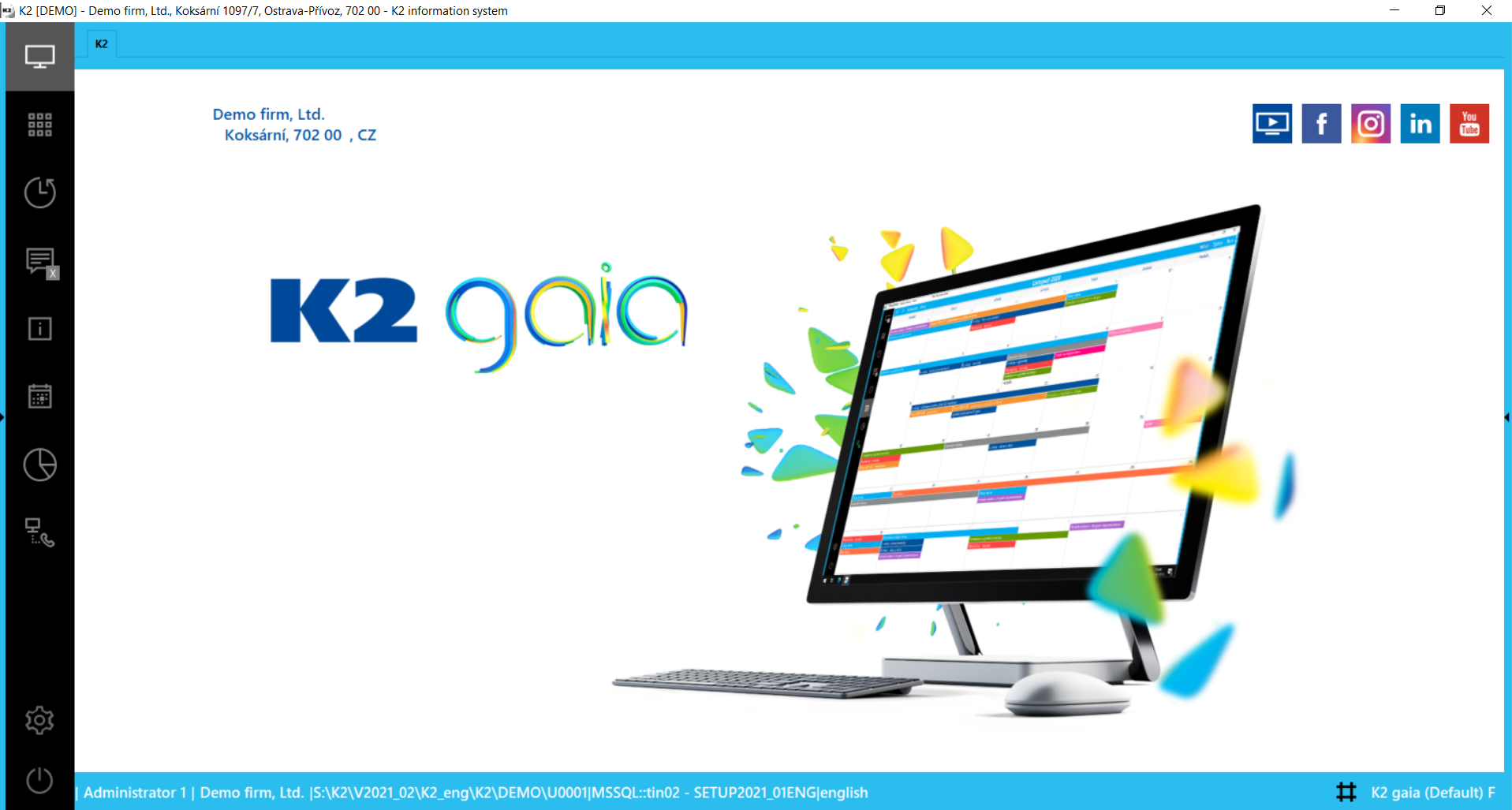
Picture: Desktop - K2 gaia
The desktop is divided into 3 parts:
- Navigation panel (left column) - it includes navigation buttons,
- Main area - it displays currently open book, documents, functions etc., which are used right now,
- Notification panel (right column) - it includes the tab with notifications. Attention:

Picture: Desktop
Desktop Items:
- Open tab in The main area of desktop.
- The name of the user currently logged on to the system.
- Name of the Company on whose data we are working at this moment.
- Path To the user directory.
- The currently set desktop.
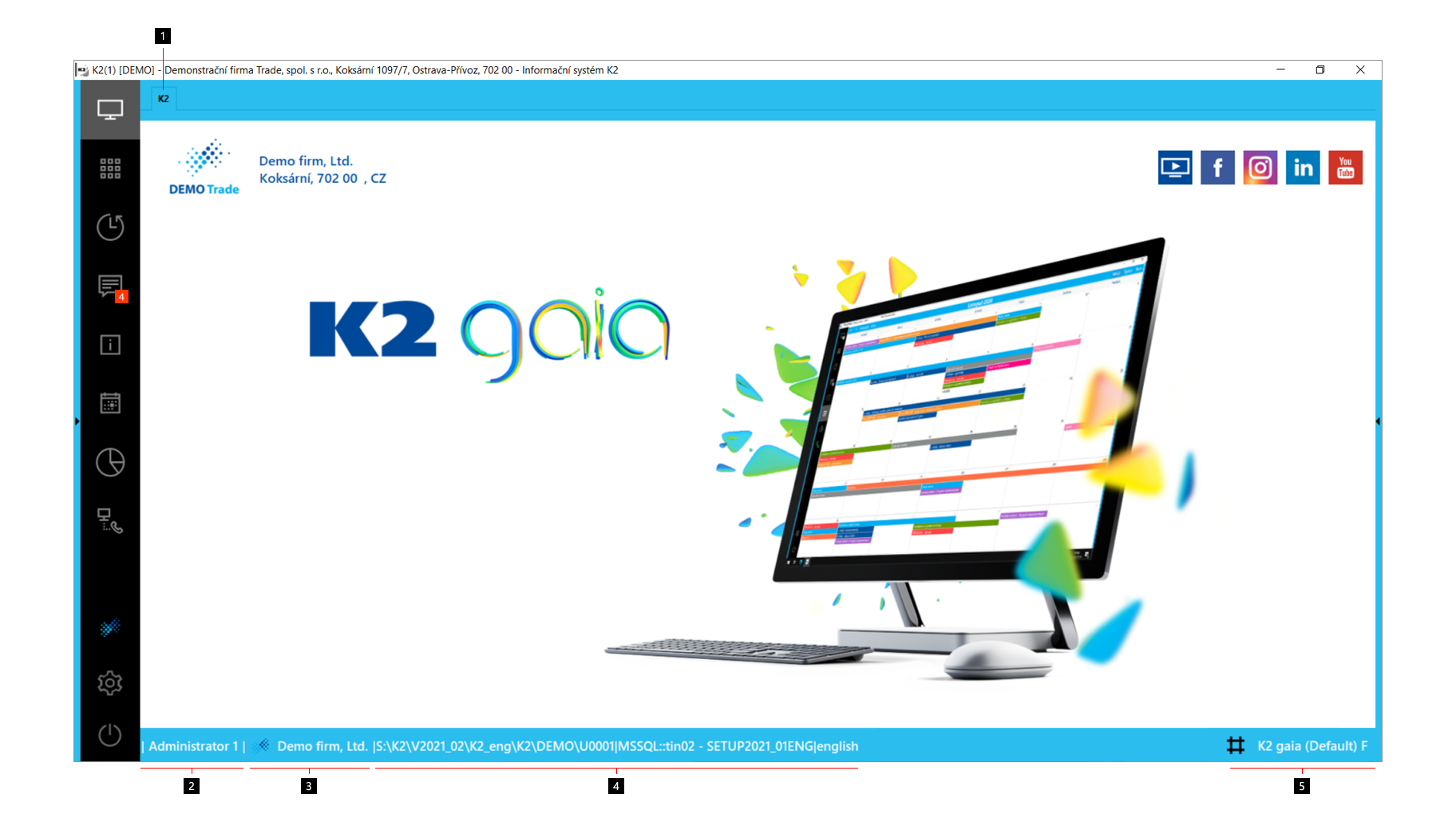
Picture: Desktop - the main screen
You can open individual modules from the desktop (books of modules, code lists). Further, you can run the function of K2 in menu, eventually you can modify the desktop design.
Change of the width of columns
In the desktop settings, there it is possible to add "splitters" to edit the width (height) of individual columns and other components of the desktop. The size can be changed by pressing the left mouse button on "splitter"and by dragging onto the required position.
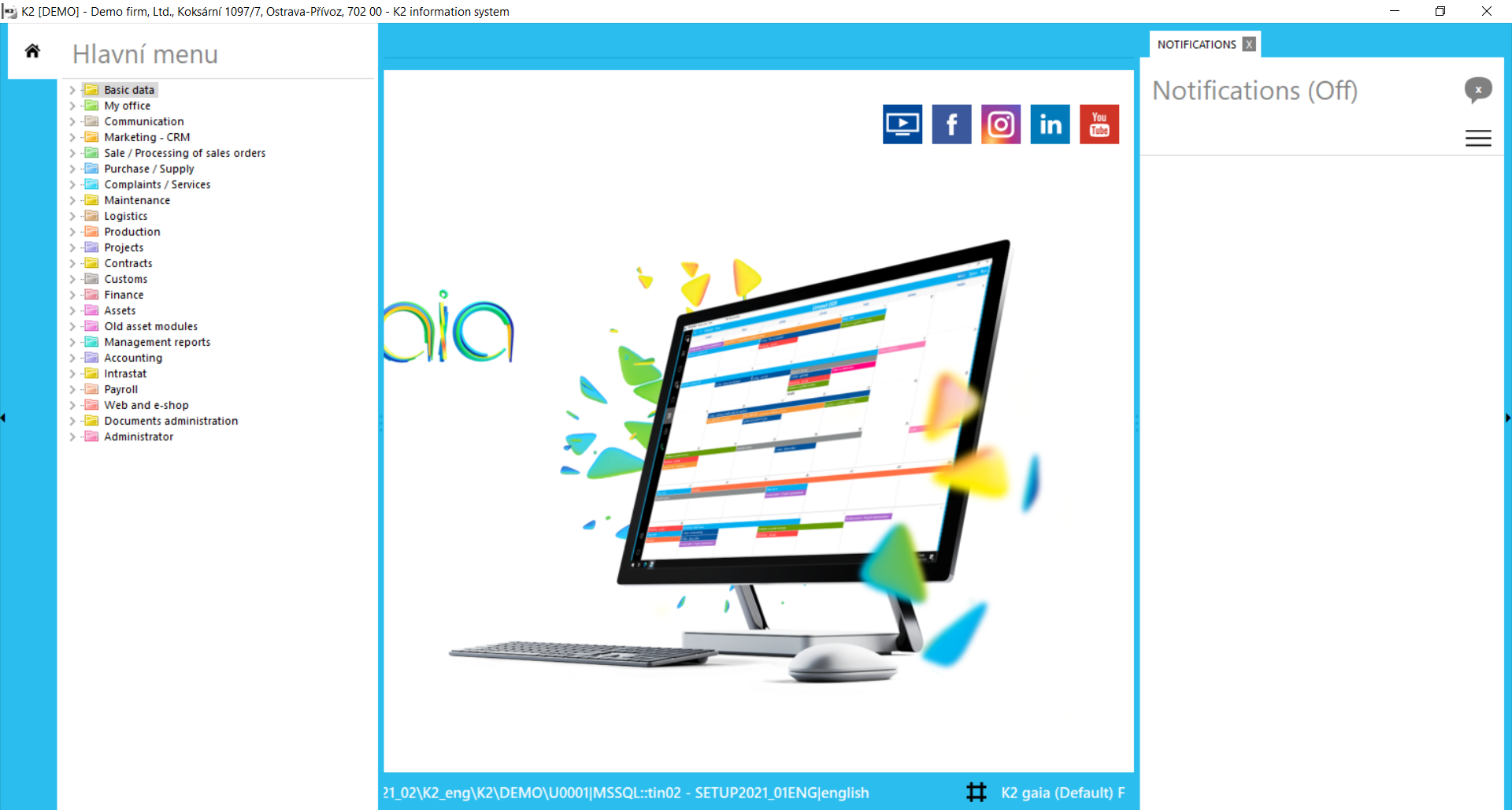
Picture: Desktop - change of the width of columns
Functions of the system K2 menu
There is also the function About K2, by which you can open the form with basic information about the version, besides the standard functions in the main menu. From the main menu you can also run Remote assistance or the list of desktops under the option Desktops. The individual desktops are either preset or created by the user (the further information about saving desktops are stated in the Desktop administration chapter).
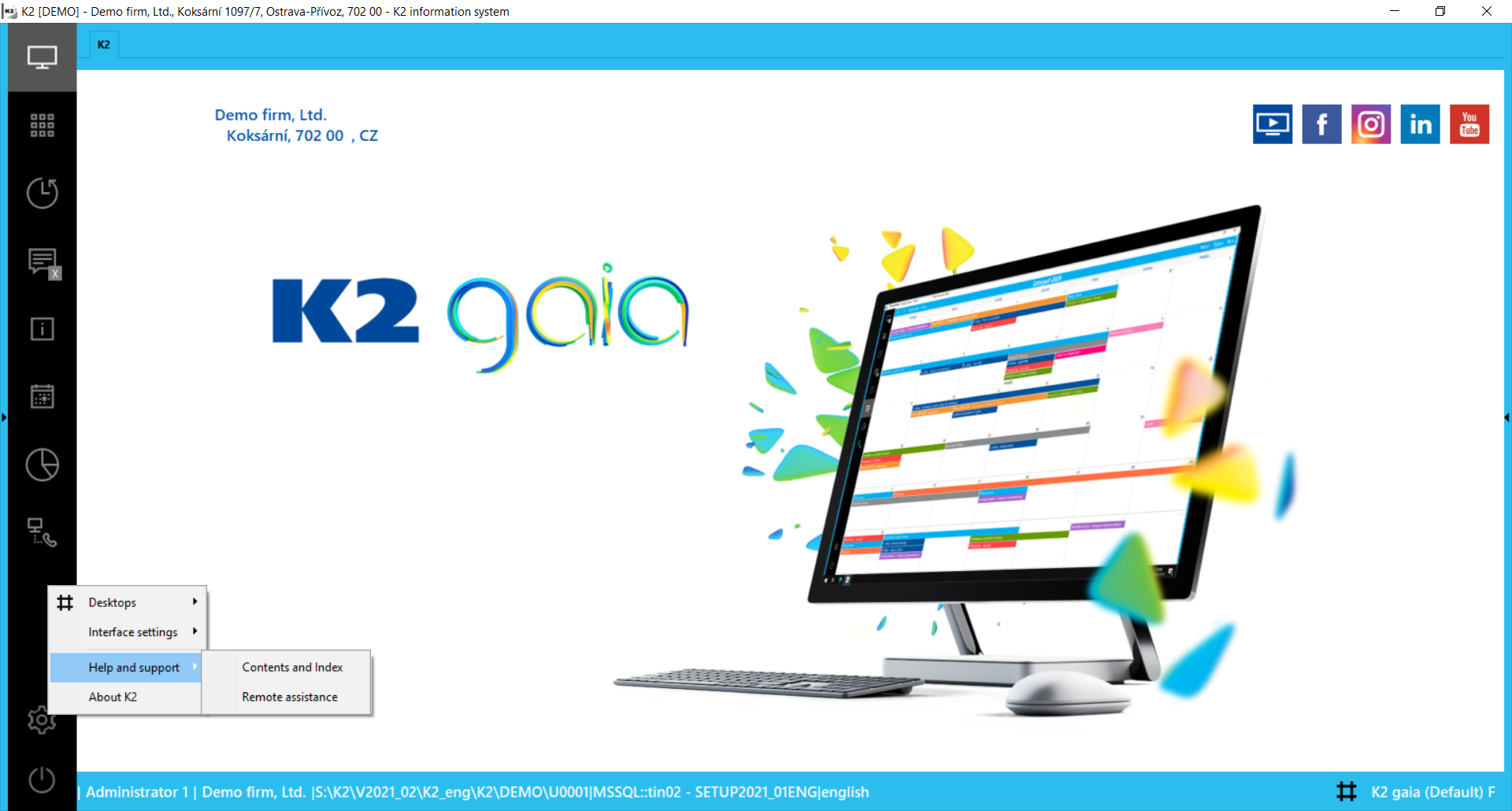
Picture: Desktop - Menu

Picture: About application form
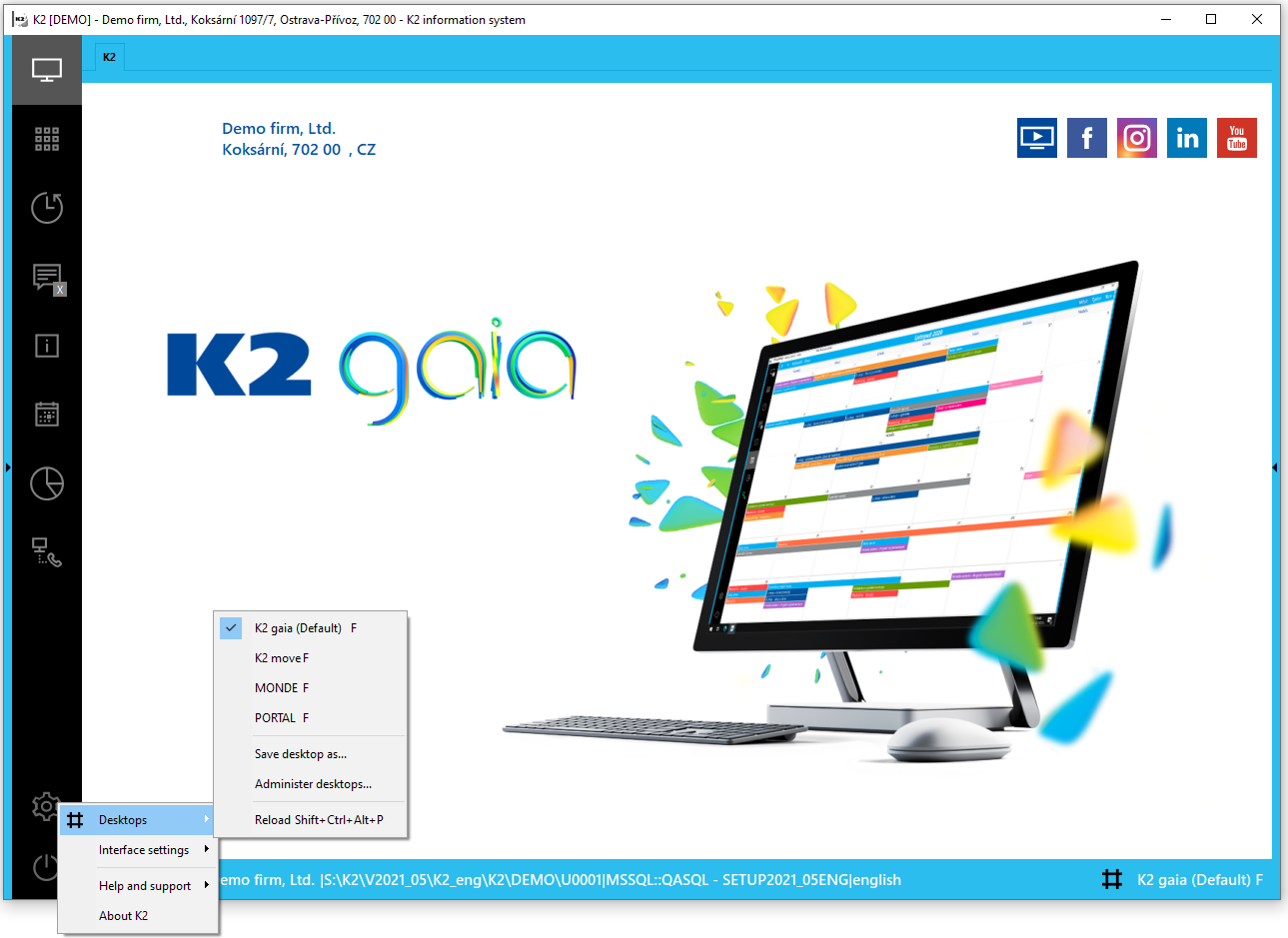
Picture: The list of desktops after pressing the Desktops option in the K2 main menu
If you select other than preset desktop (your own created desktop), then The option Edit desktop will be displayed in the main menu in addition. The further description of this function is described in Desktop administration chapter
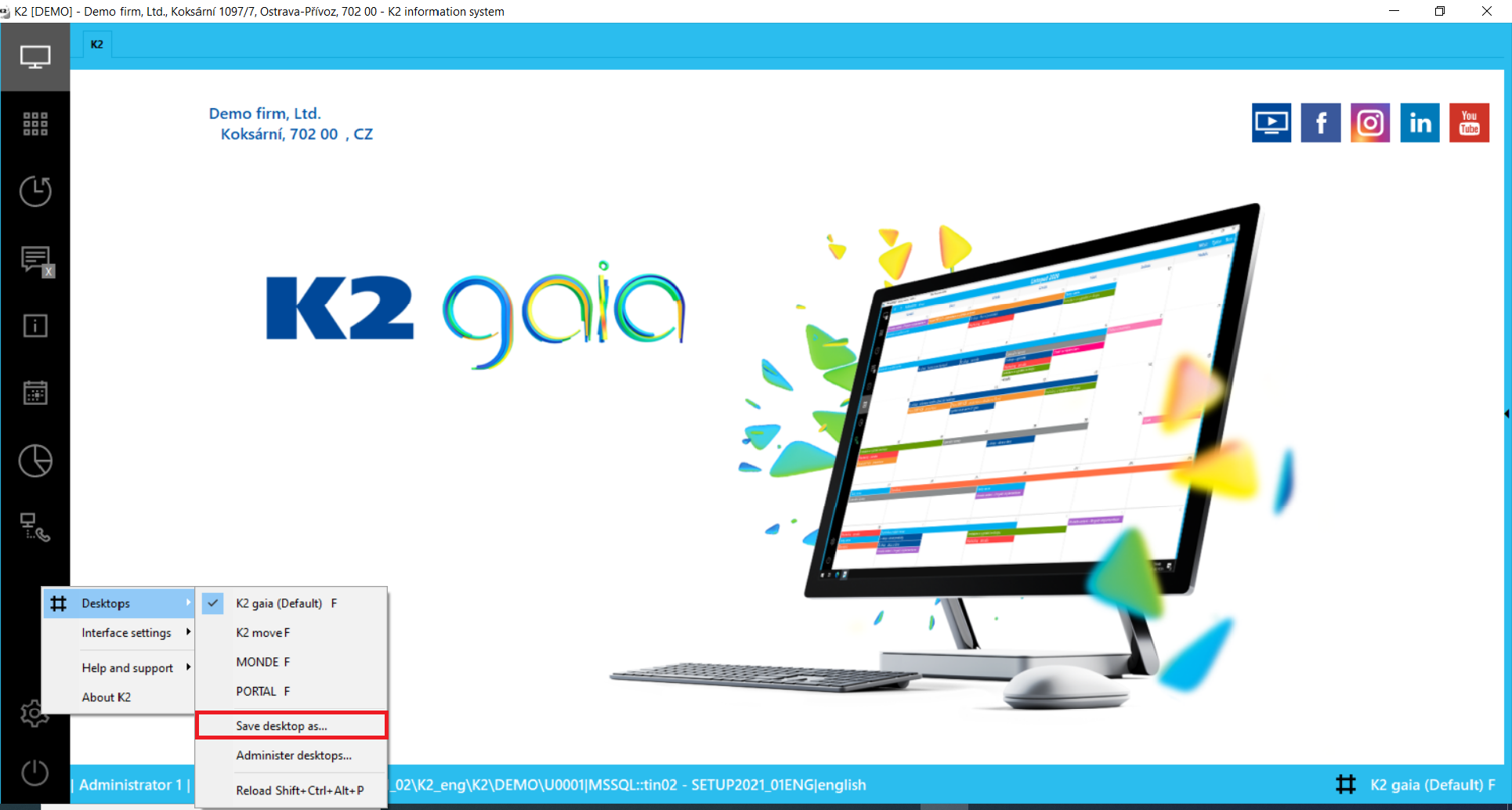
Picture: Main menu options after setting "own" desktop
The functions About K2, Remote assistance and Desktops can also be started from the bottom panel K2. Remote assistance is located under the Help and support option. There is also Contents and Index to get help from.
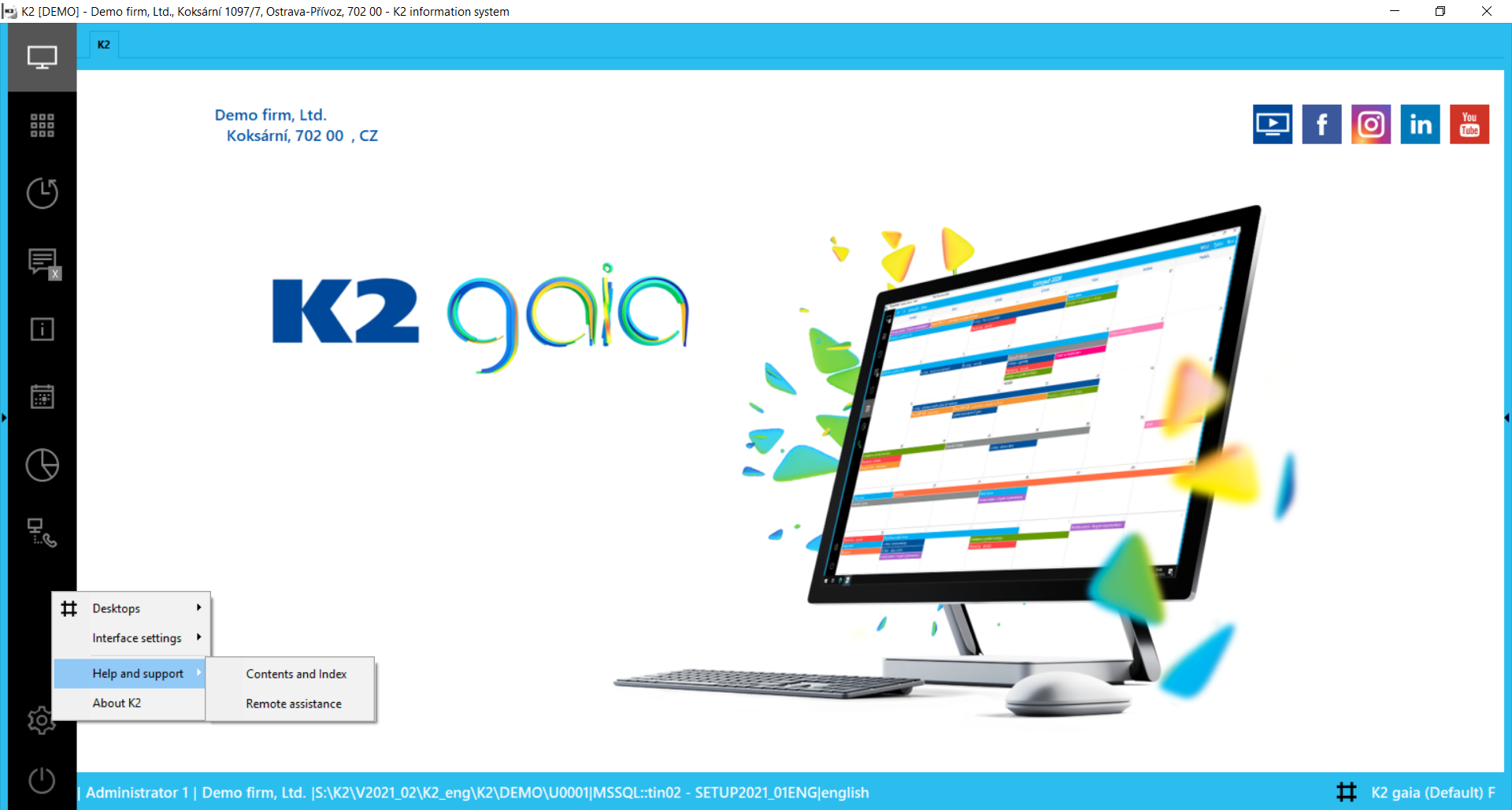
Picture: Desktop - Help
Desktop - navigation panel
The navigation panel serves for quick start of the functions, it contains the following buttons:
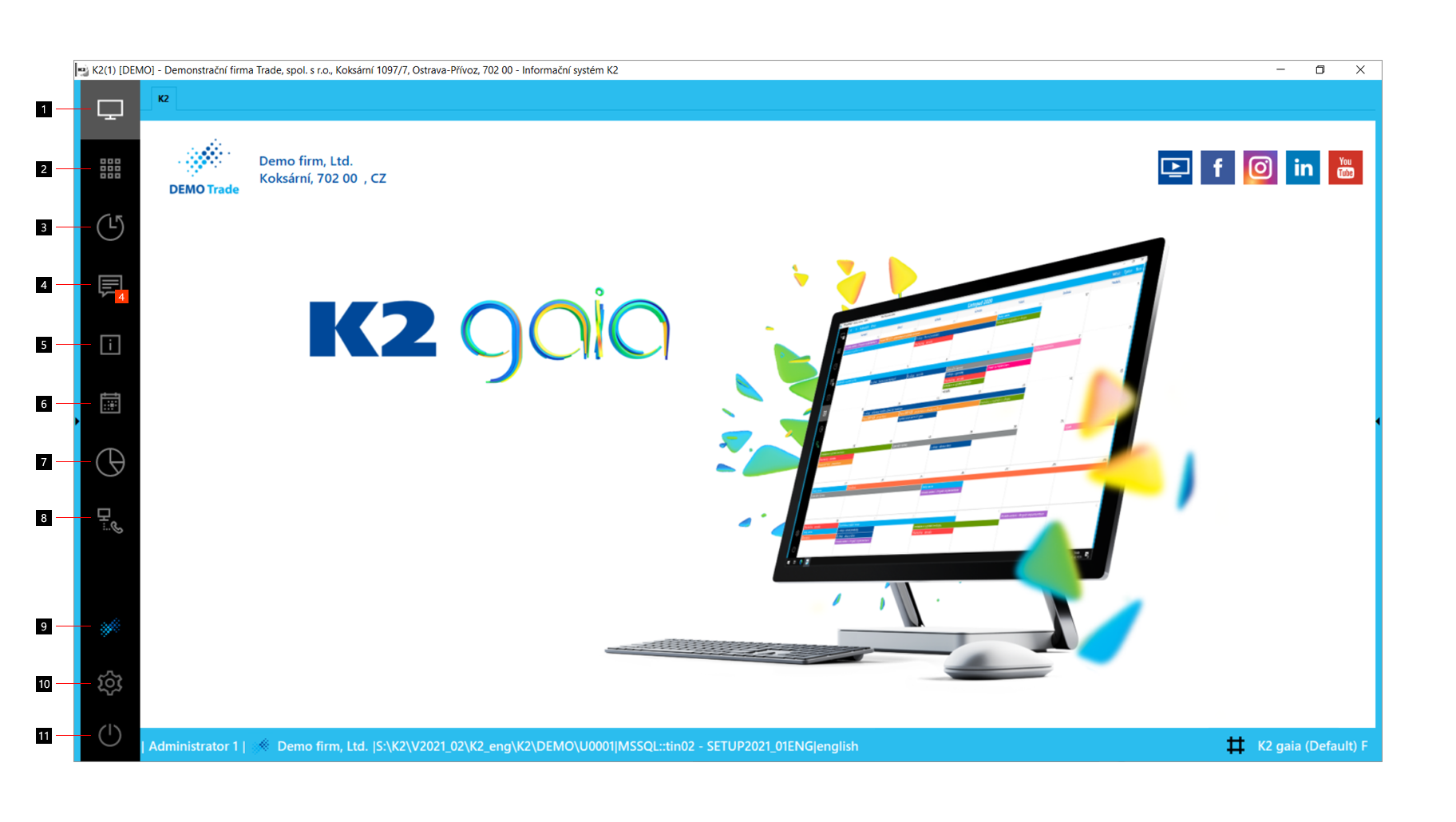
Picture: Desktop - navigation panel
Buttons' Description:
1 |
It displays the initial screen in the main area of the desktop.The main area of desktop. |
2 |
It displays a tab with tree menu, Default tab and Favourites tab. |
3 |
It displays tabs with a list of recently launched functions and the history of the displayed entries. |
4 |
The button displays a number of received notifications (number in thered frame). A notification panel is displayed after pressing this button. |
5 |
It displays the information panel with messages from thehelpdesk. |
6 |
Displays calender. |
7 |
Display the main menu. |
8 |
Call management button. |
9 |
Button to switch a company in Clients For more information see the Administrator in Administration of own companies chapter. |
10 |
Button for desktop settings. |
11 |
When pressed, the button turns red, and when pressed again, the user is logged off and K2 is turned off. (There is a double confirmation here to prevent the K2 frombeing accidentally turned off.) |
These buttons run functions into the main area of the desktop.The main area of desktop.
Last run
This button shows the most recently run books, scripts, features, etc. Shows only the 15 most recent records. The records can be grouped acc. to types using the button shown inthe red box.
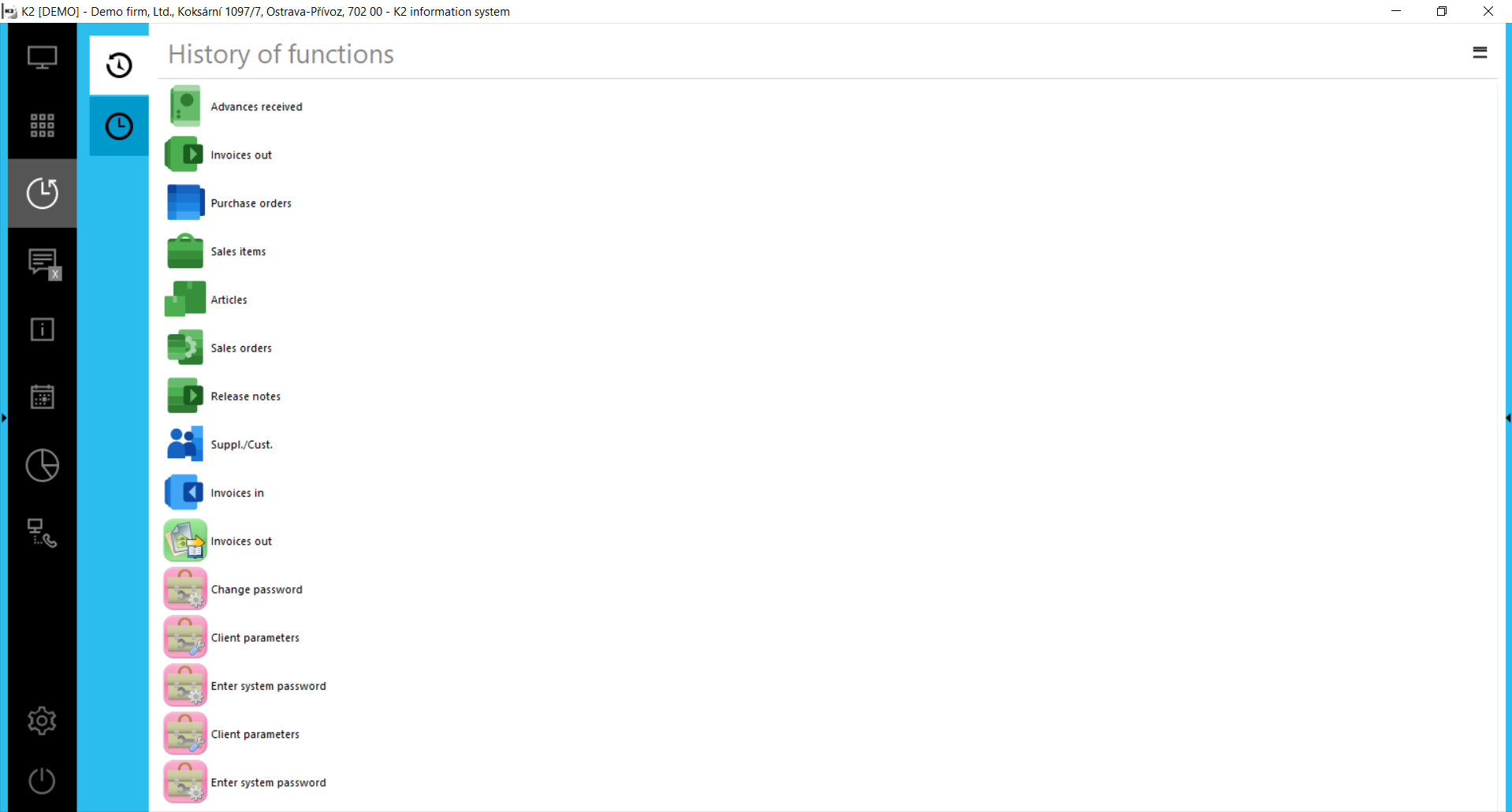
Picture: Last run - Not grouped Records
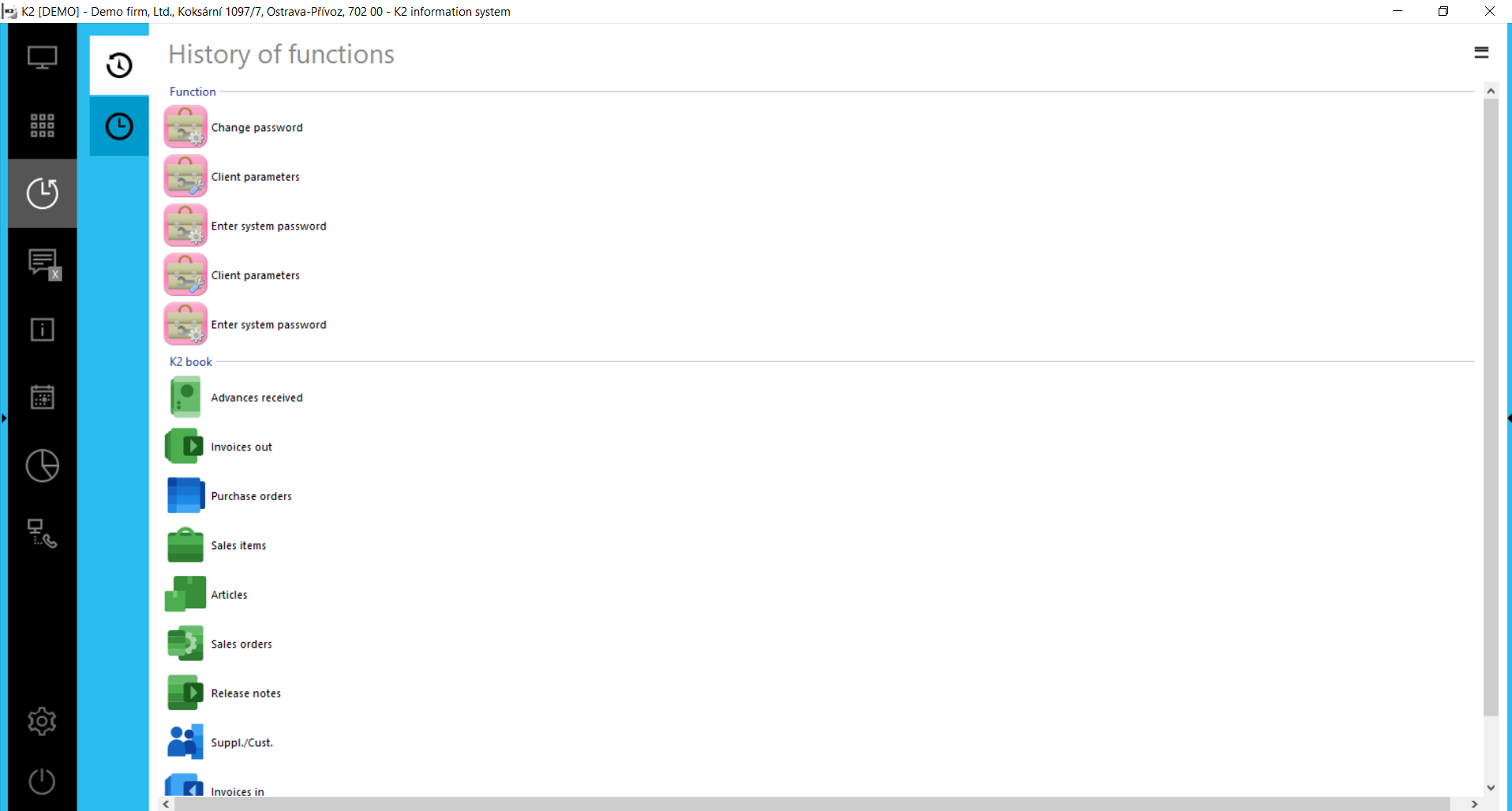
Picture: Last run - Grouped Records
Double mouse click on the icon to run the function, book, etc.
Further possibilities to work with records
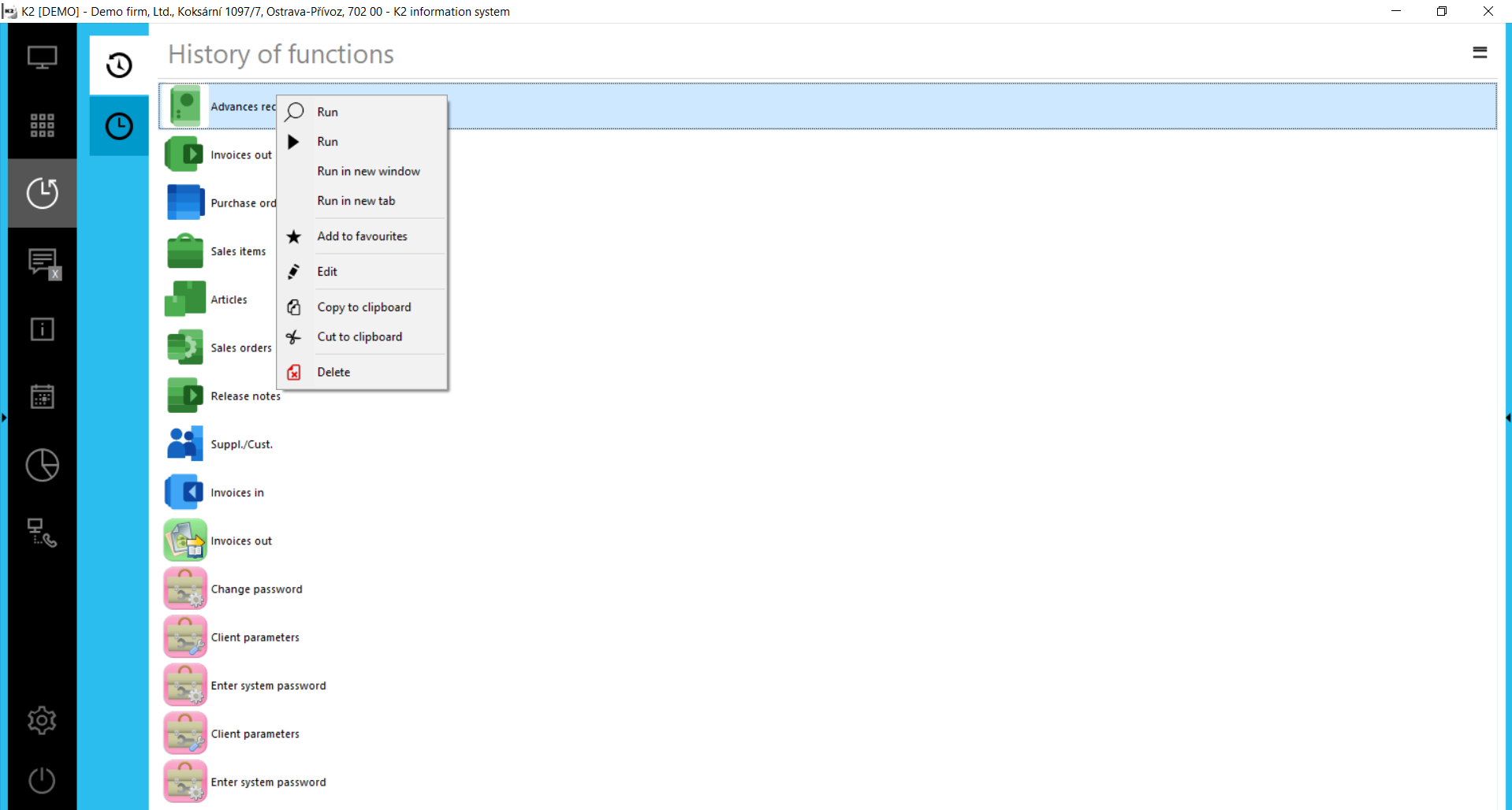
Picture: Last run - options
After pressing the right mouse button on a record, the same options as on the Favourites tab of the desktop will be displayed. The record can also be deleted by Remove option or by Delete key.
Add to favourites option inserts the record as icon into the Favourites tab.
Copying of records
- Click by the right mouse button - select Copy option and after that click by the right mouse button - and select the Paste option. Records are inserted into the left part of desktop, into the Favourite tab.
- Drag to Favourites tab.
- The Ctrl+C (copy) and Ctrl+V (paste) keys shortcuts also work. You can insert it into the Favourites tab.
Note: Records are inserted into the Favourites like icons.
Attention:
The function starts the panel within coming notifications in themain desktop part The main area of desktop. Number in In red box function![]() informs about number of incoming notification. This panel is the same with notification panel, and so all the functions are the same. Description about notification panel is in Notifications chapter.
informs about number of incoming notification. This panel is the same with notification panel, and so all the functions are the same. Description about notification panel is in Notifications chapter.
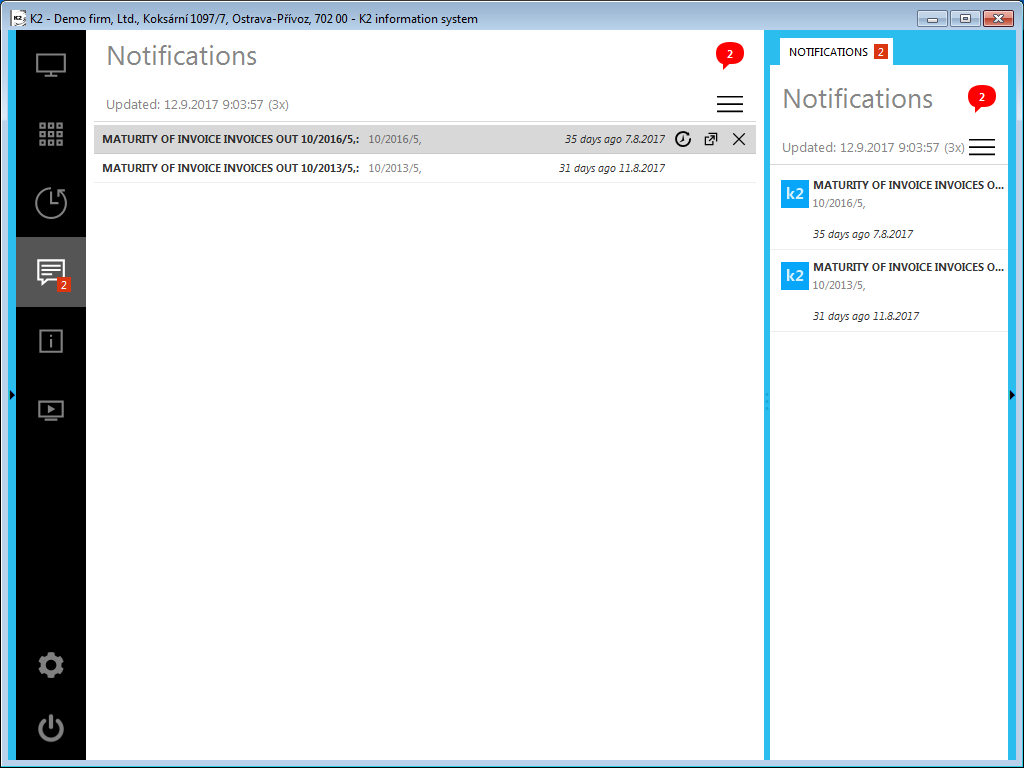
Picture: Desktop - Notification
History of records
There is a list of documents that were edited on the History of records tab. If you press the icon Follow also visited records (in the red box), also the history of documents that you have only browsed and have not changed is saved.
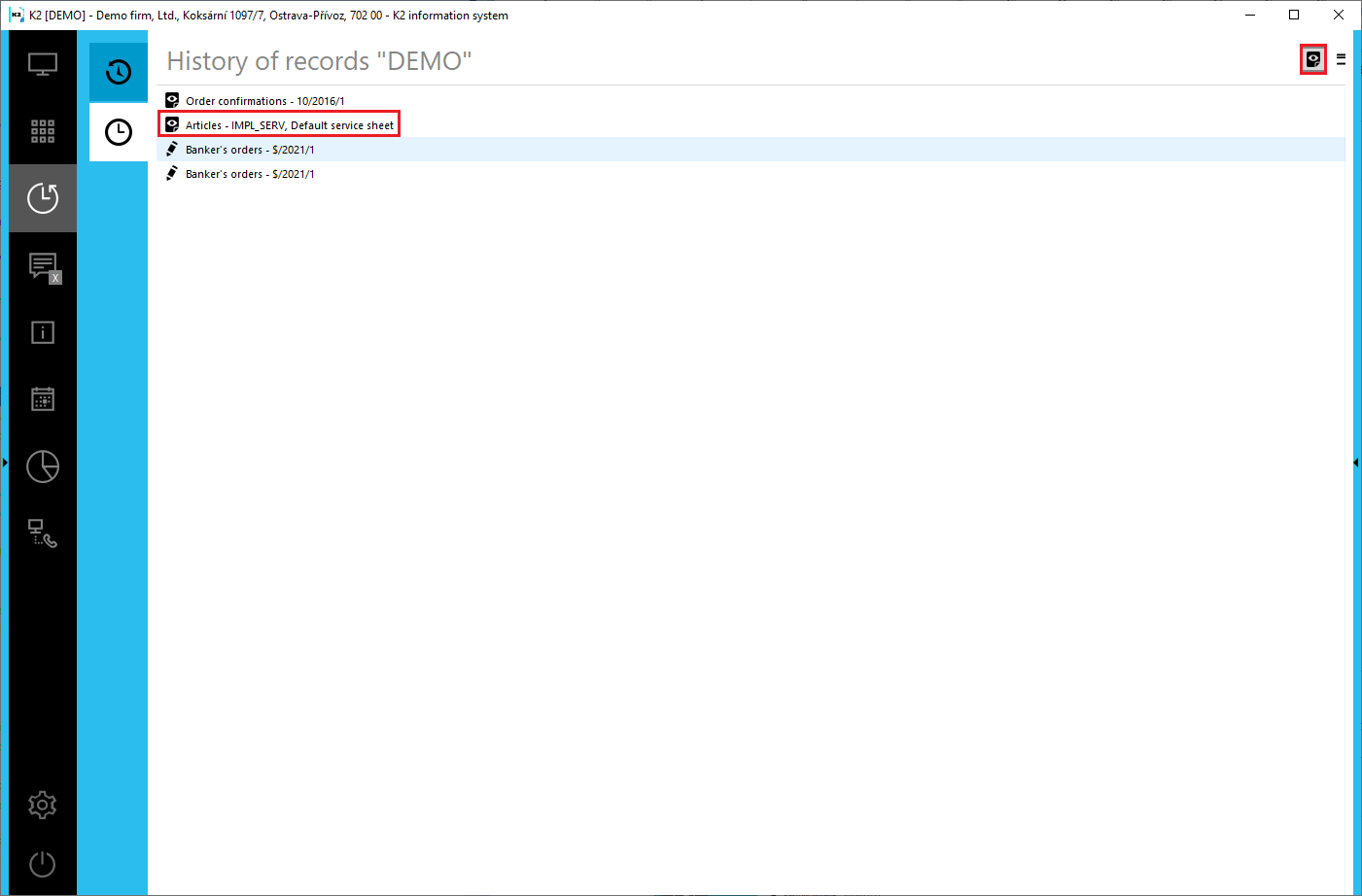
Picture: Desktop - History of records
History of records is saved for User and Client. In the heading of the history of records, there is a name of the client, who the history is displayed for.
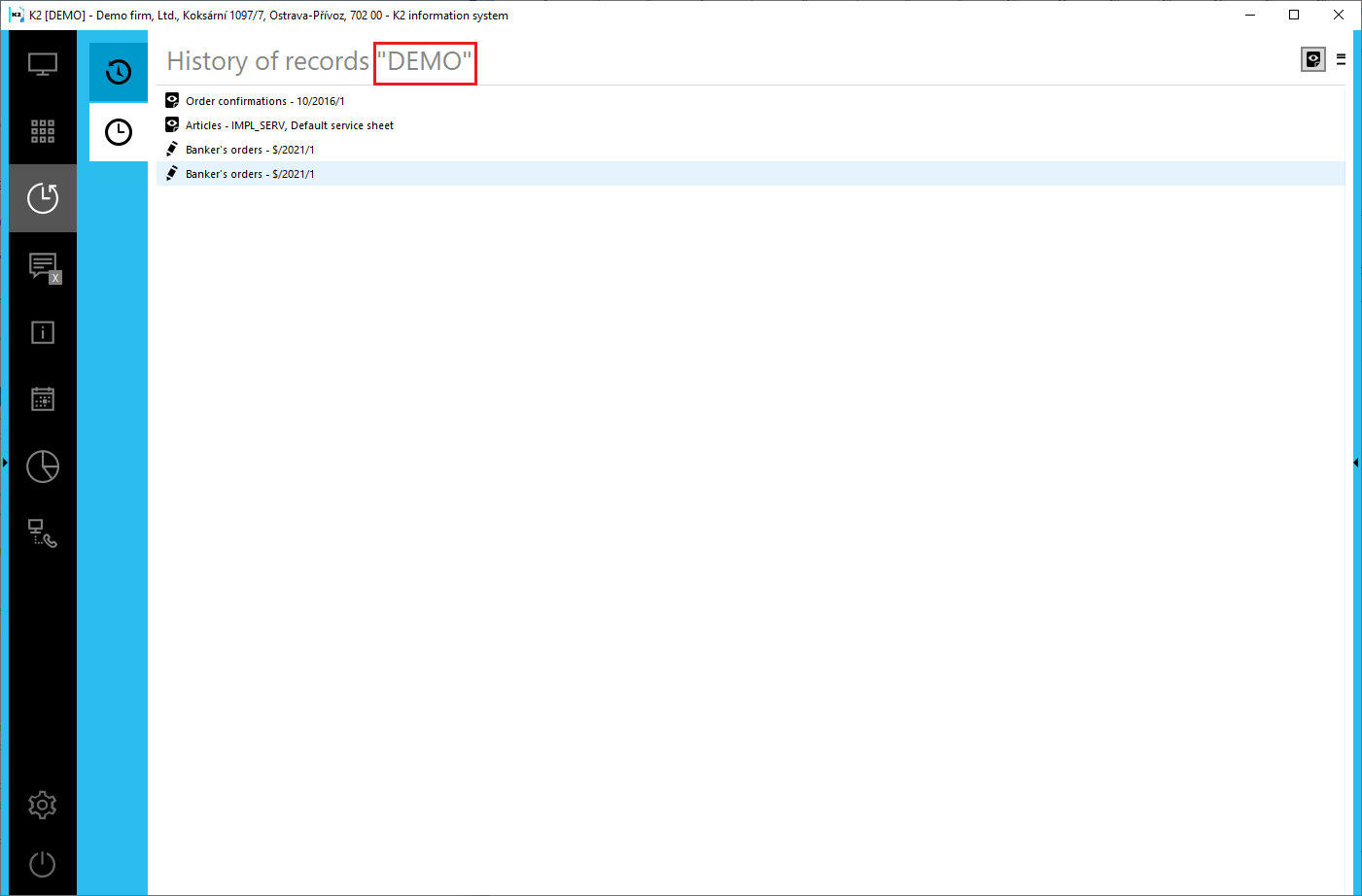
Picture: History of records - display the Client
If there is a cursor over the record, a "hint" date and time when the record was displayed/changed is displayed.
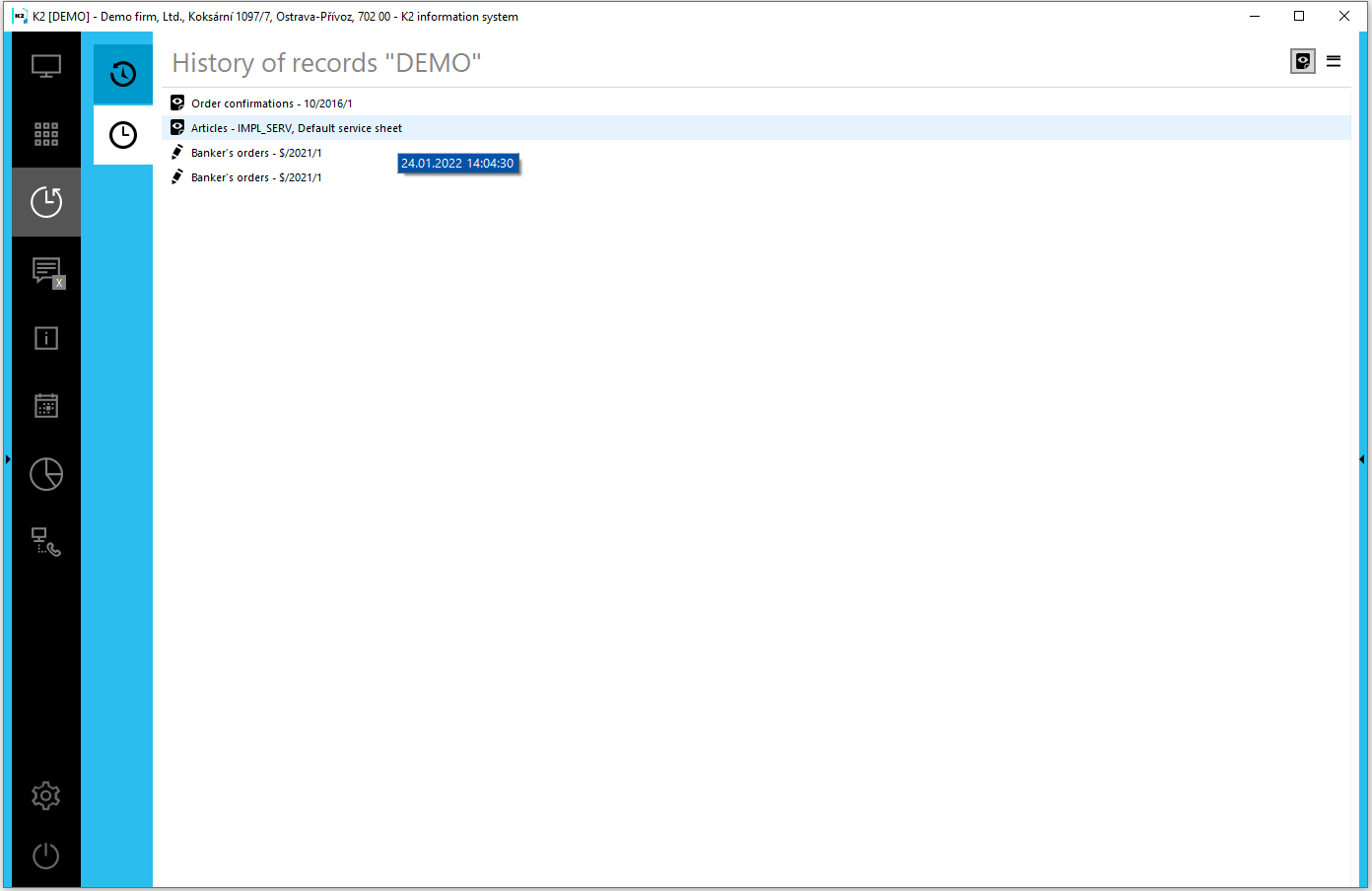
Picture: History of records - date and time
You can switch over the document from history by double click on the left mouse button. E. g. open a sales order that is indicated by a green box.
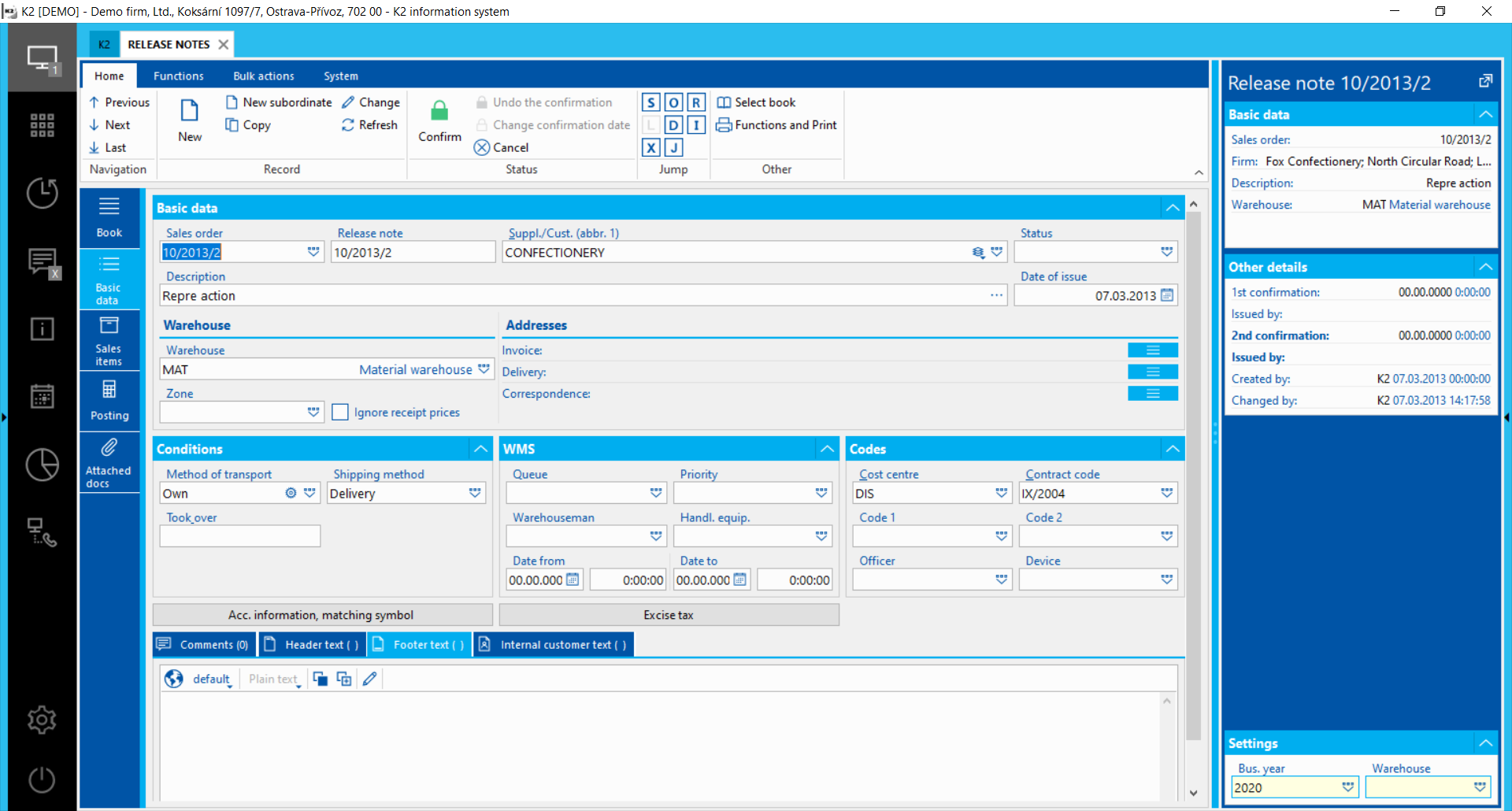
Picture: Opened release note
If you switch over a document that you browse and edit in the past, then document character![]() changes to a character
changes to a character![]() .
.
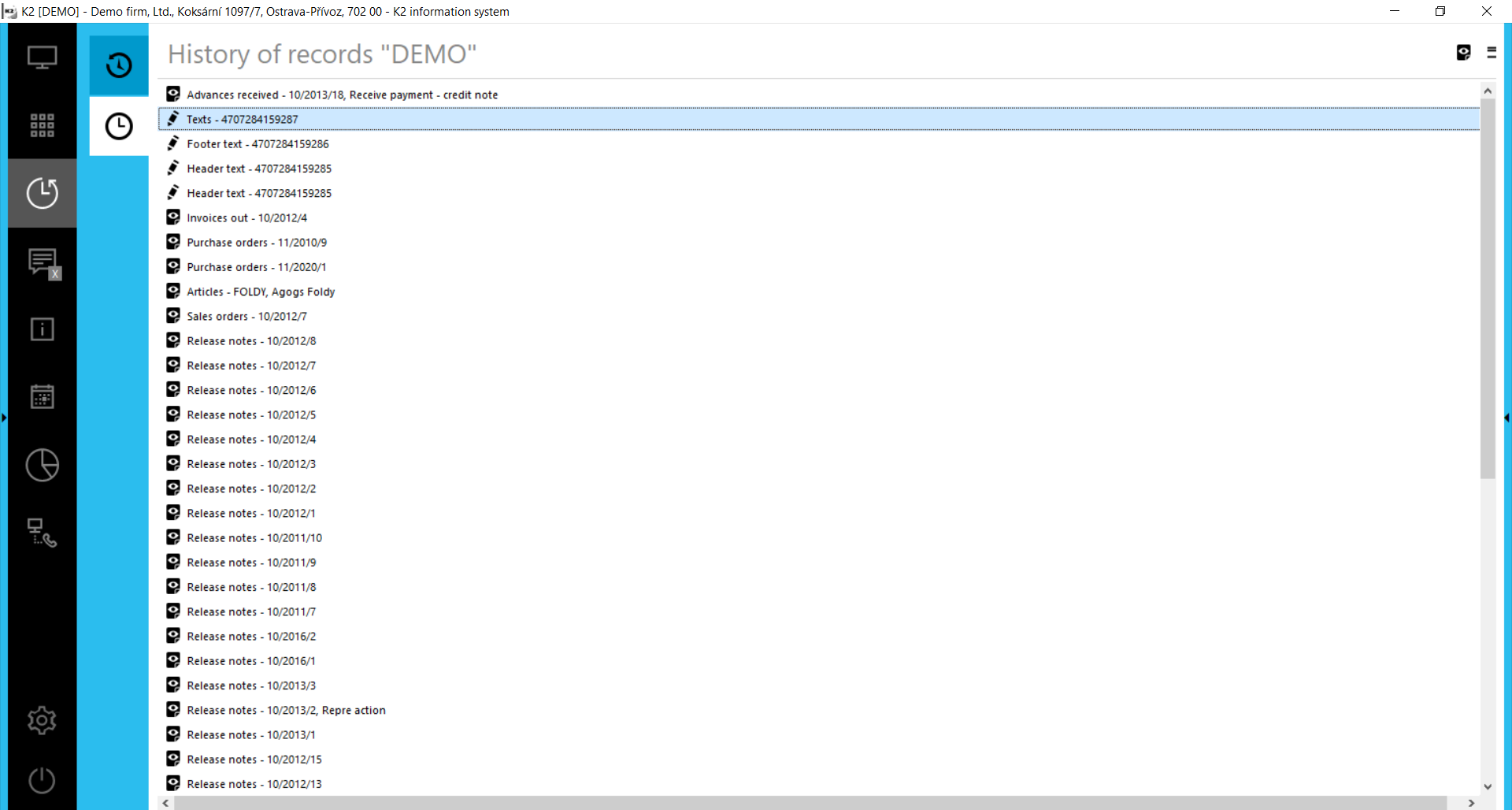
Picture: Record of modified invoice out
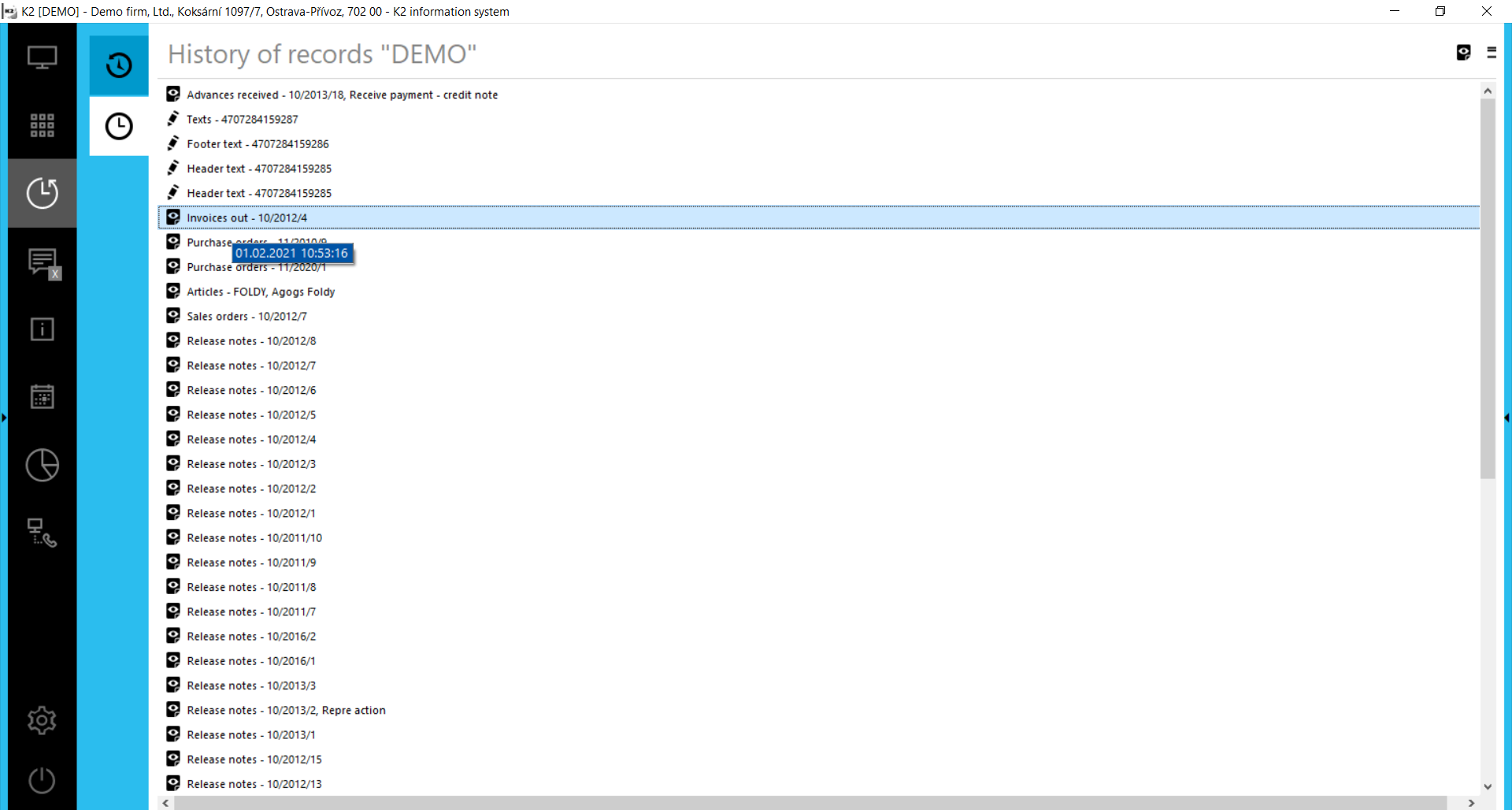
Picture: Record of modified invoice out
Further possibilities of work with history of records
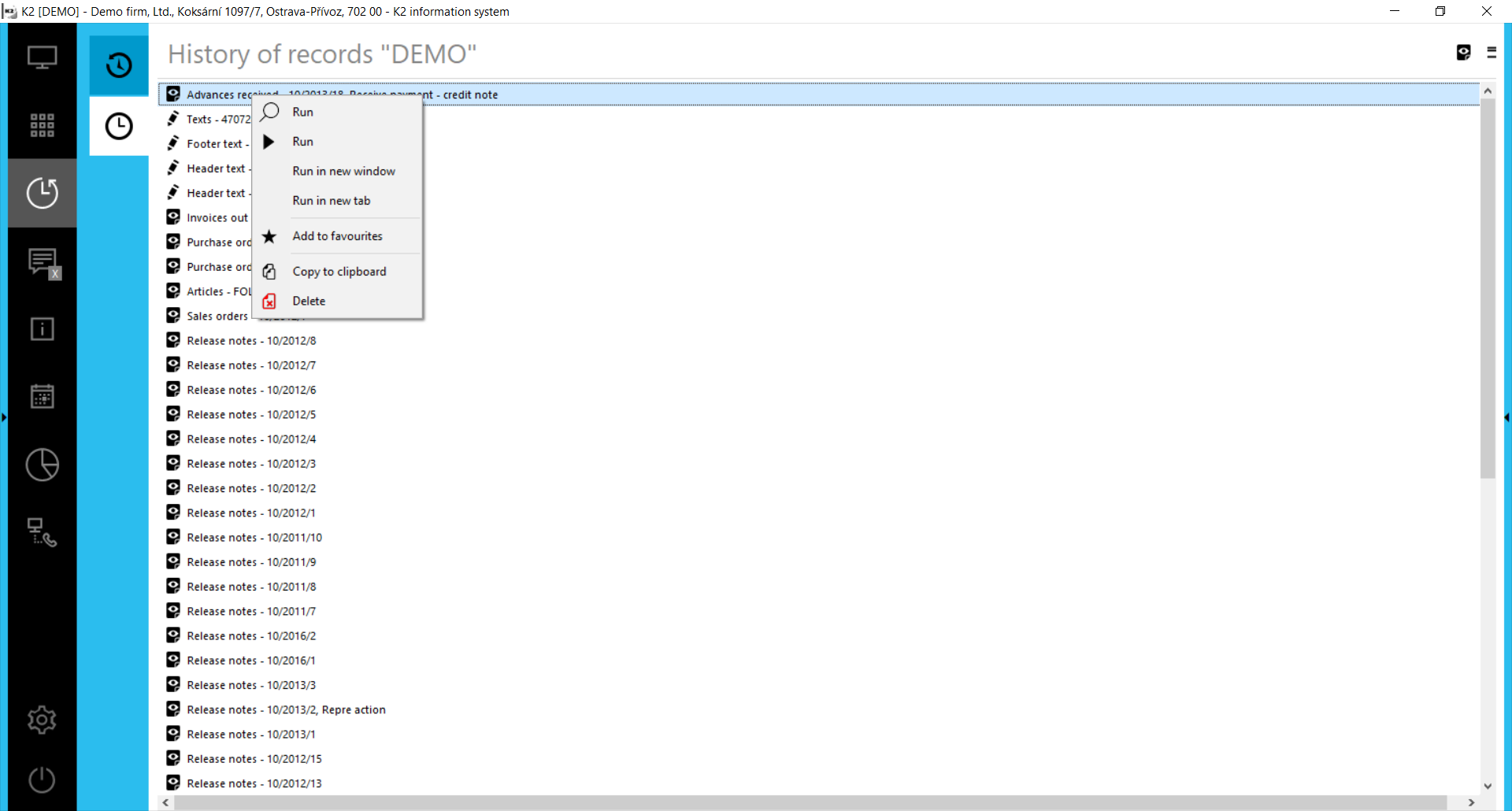
Picture: History of records - possibilities
After pressing the right mouse button on a record, the same options as on the Default tab and the Main menu tab of the desktop will be displayed. Copying records is similar to Recently started records.
Grouping records
For a better transparency among records you can use the function Display groups (in the red frame). This function groups the records according to a book (data module), in which the record is located.
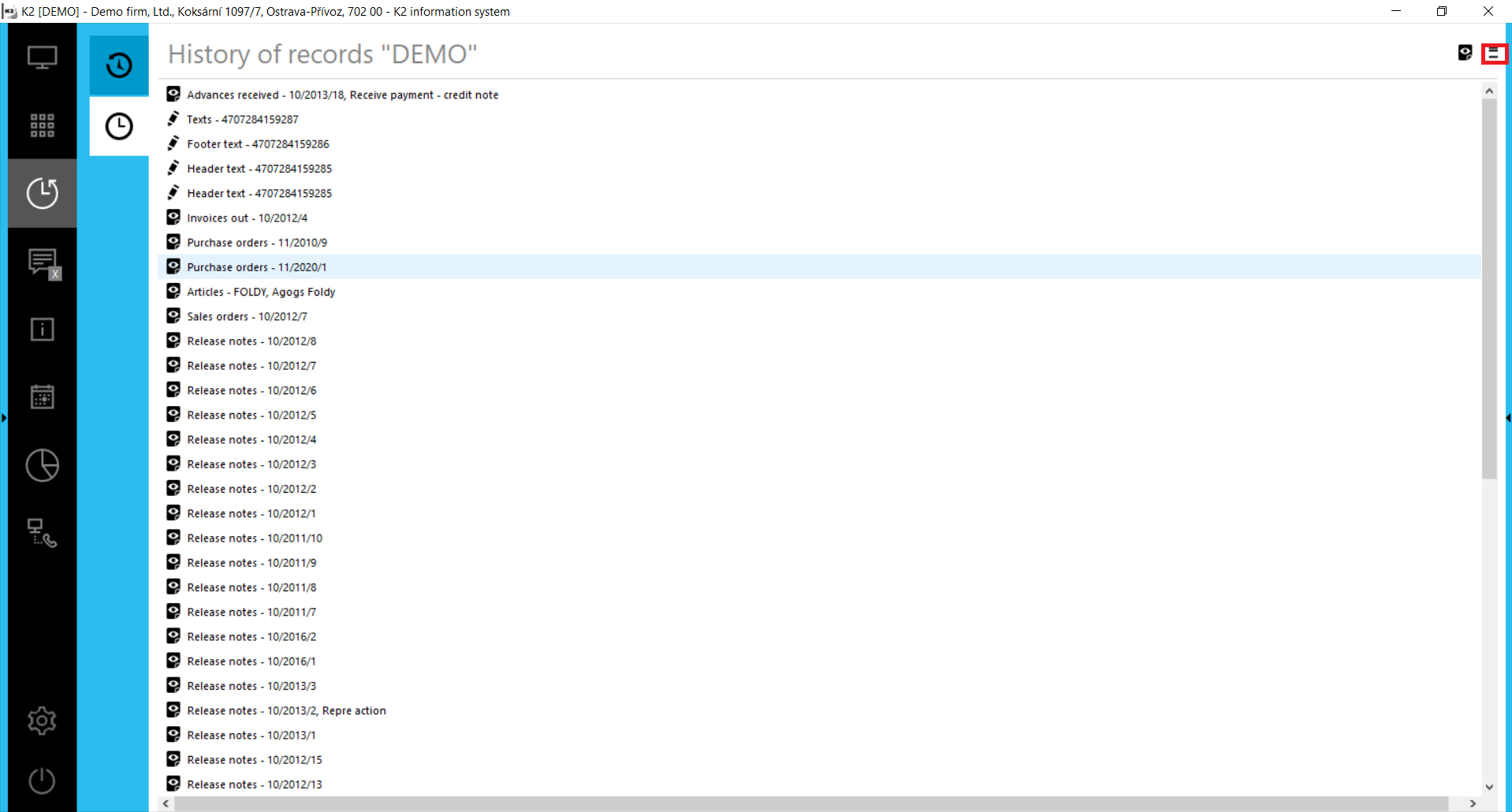
Picture: Not grouped records
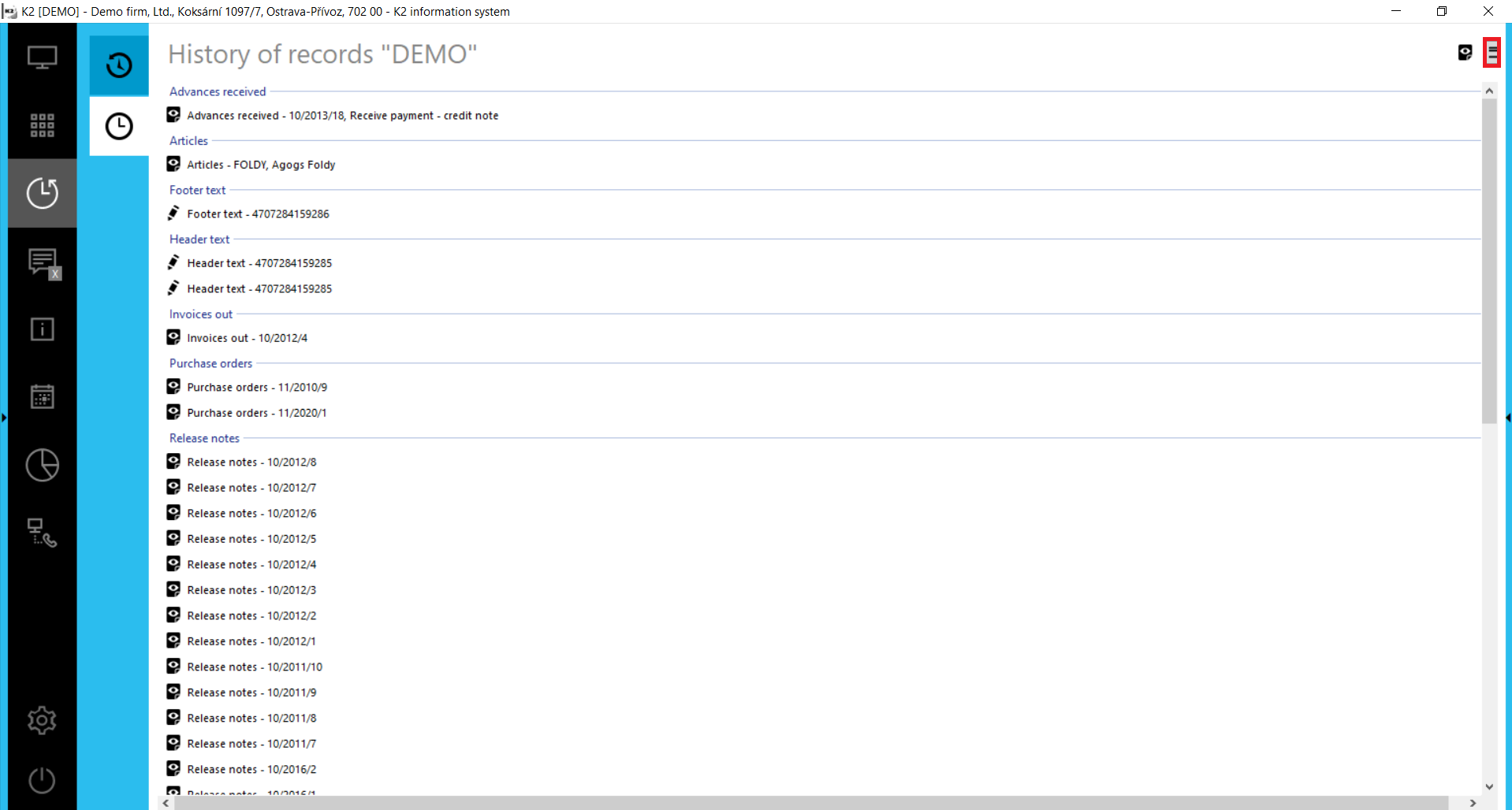
Picture: Grouped records
User manual K2 and Helpdesk
![]() This function of navigation panel includes two tabs: User manual K2 and Helpdesk.
This function of navigation panel includes two tabs: User manual K2 and Helpdesk.
User manual K2
This tab displays the most up-to-date information aboutK2 atmitec. E. g. this is E. g. information about upcoming workshop, about new version releases, etc.
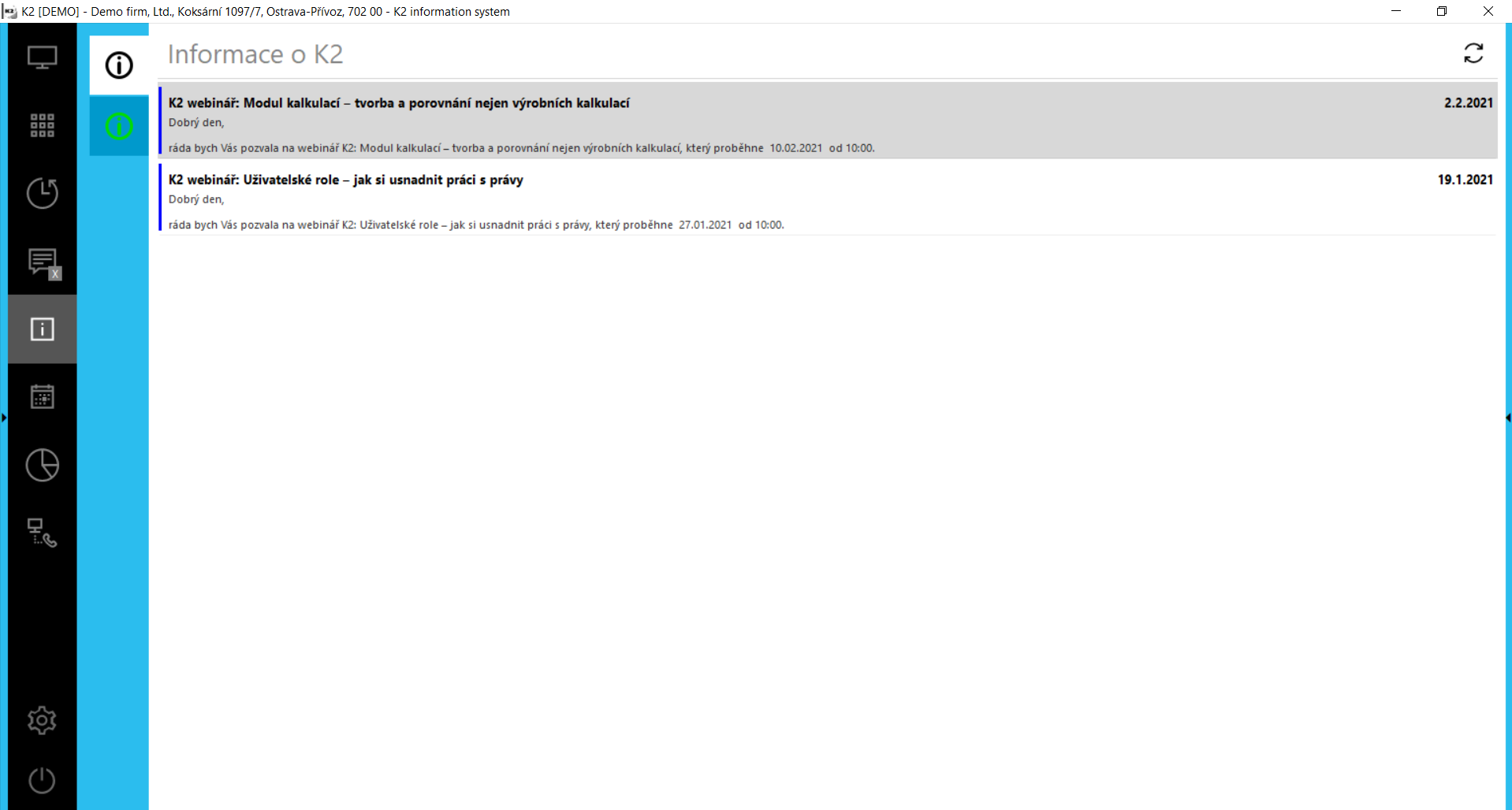
Picture: Desktop - User manual K2
Helpdesk
The helpdesk tab contains the news and error messages. It is possible to filter individually news and errors. We filter news with the button ![]() and errors with the button
and errors with the button![]() .
.
![]() - it refreshes the page with helpdesk.
- it refreshes the page with helpdesk.

Picture: Desktop - Infoservice
IS K2 enables the users to publish the contributions to helpdesk customer support directly from the desktop. This function is accessible to the user who is linked with a Contact person In the book of Contact Persons, we will switch to the Web, e-shop tab for a specific user.
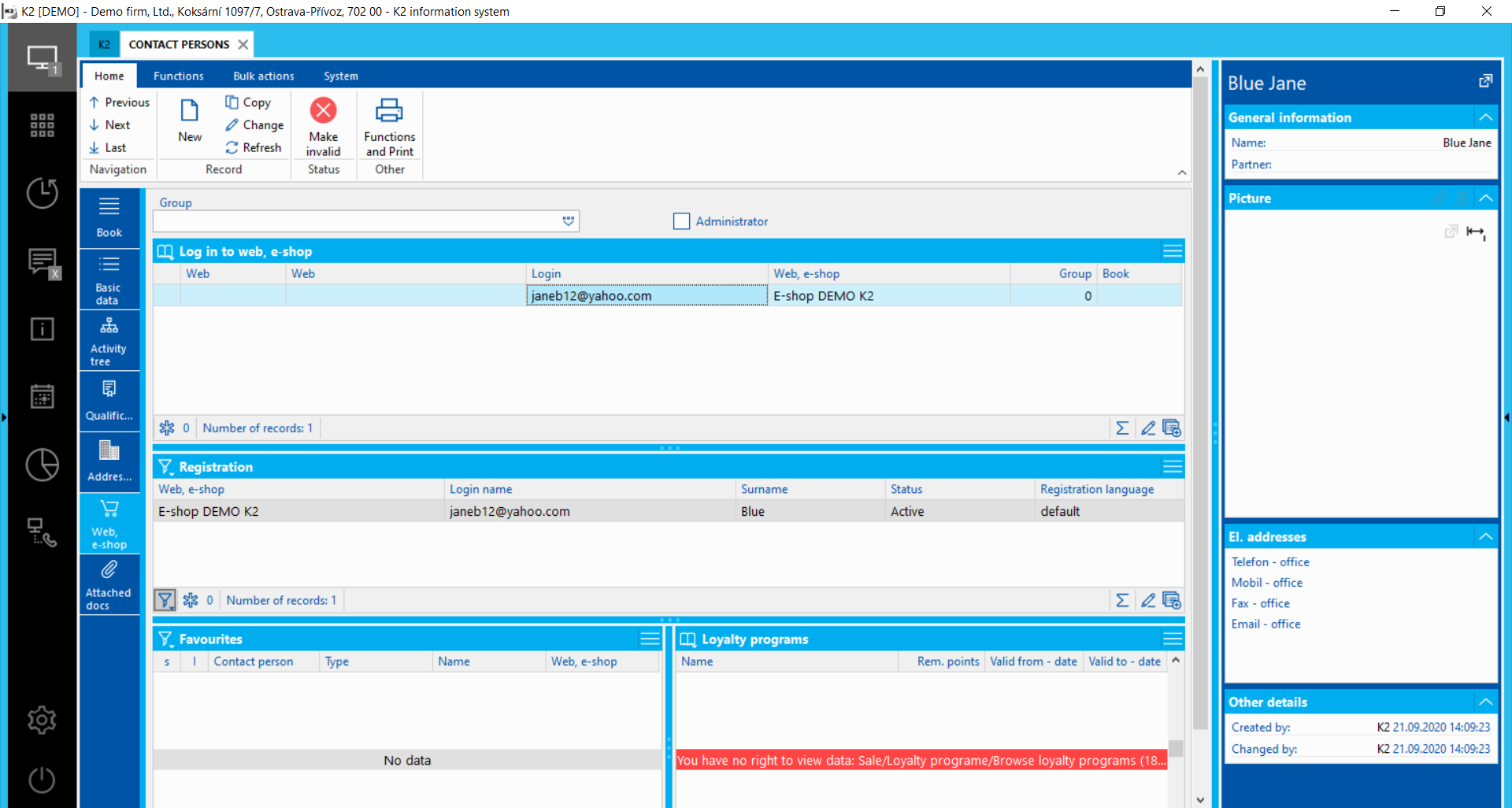
Picture: Tab of Web, e-shop
When logging in to the website, e-shop, the login details for the info service must be set.
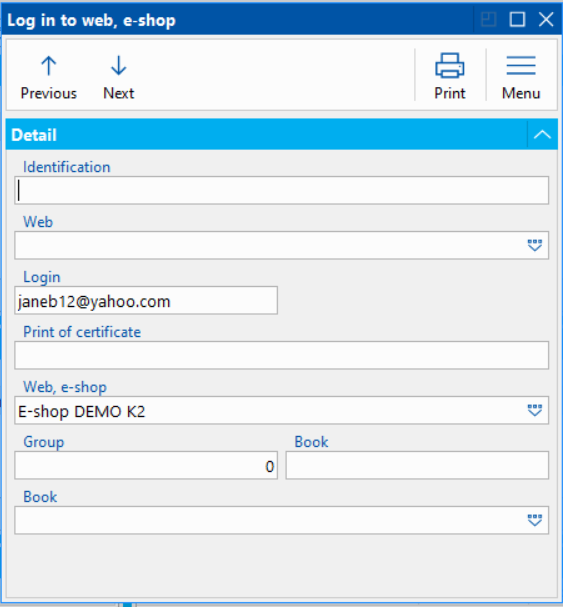
Picture: Login to the Infoservice
In the form for entering login data into the helpdesk, it is necessary to set the option helpdesk in the Web field. The program identifies according to this setting that it is the login information to infoservice and makes the possibility for entering requests of the customer support from the K2 IS accessible.
If the Infoservis entry does not yet exist in the Login to the website e-shop code list, we will create it. In the new record form, fill in only the Abbreviation and Description fields. Save the record.
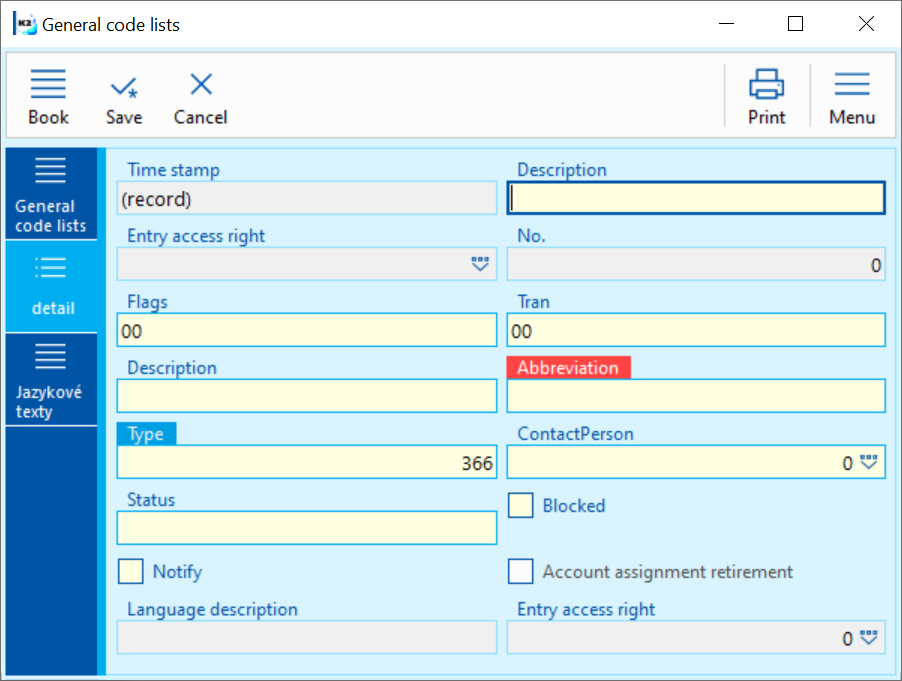
Picture: New Record Helpdesk
This option is available only after the fulfilment of all conditions, it means Interconnecting IS K2 user with a contact person and setting access data on the appropriate contact person. Use the icon ![]() to display options where we can display the form via the Help - New helpdesk request menu. After you meet all conditions, i. e. connect IS K2 user with the contact person and set access data on the given contact person, the possibility will be available. Form New requirement then creates the record in Helpdesk and its properties.
to display options where we can display the form via the Help - New helpdesk request menu. After you meet all conditions, i. e. connect IS K2 user with the contact person and set access data on the given contact person, the possibility will be available. Form New requirement then creates the record in Helpdesk and its properties.

Picture: New requirement form
Field Description:
Requirement name |
The field for entering a contribution name of helpdesk customer support. |
Requirement type |
Customer support requirement type:
|
Requirement priority |
Customer support requirement priority:
|
Steps to reproduce error |
The field for a detailed description of the reproduction of reported error. |
More details |
Field for more details that relate to entering customer support contribution. |
Previous changes |
The checkbox to determine changes, that preceded the reported error. |
Problem relates to |
By using these checkboxes, you can determine, what the reported error relates to. |
Attach files |
By using these checkboxes, you can attach the files to the customer support:
|
Attached docs. |
The tab for inserting attachments to the customer support. Here, you can paste Print Screen of the screen. |
Desktop - the main screen
Tabs Favourites, Default and Main menu:
- Favourites - this folder is empty by default. There is possible to add any icons that will be used frequently. Only the user who has created the list of icons sees it. Icons can be added either by pressing right mouse button or by dropping by the mouse from the Default tab. Further description see the Work with icons chapter.
- Default - default list of icons.
- Menu - tree menu.

Picture: Desktop - Favourite tab
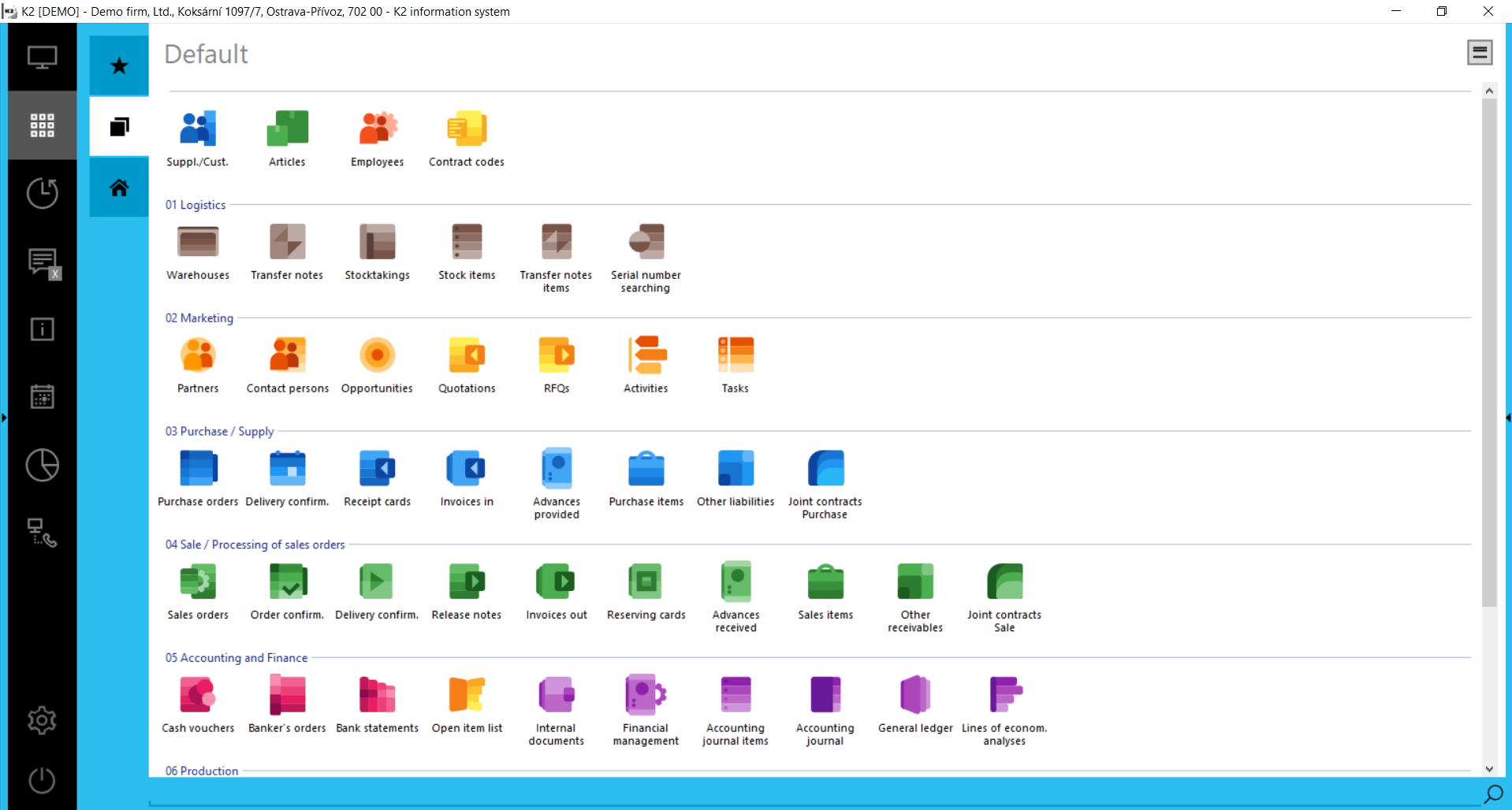
Picture: Desktop - tab Default tab
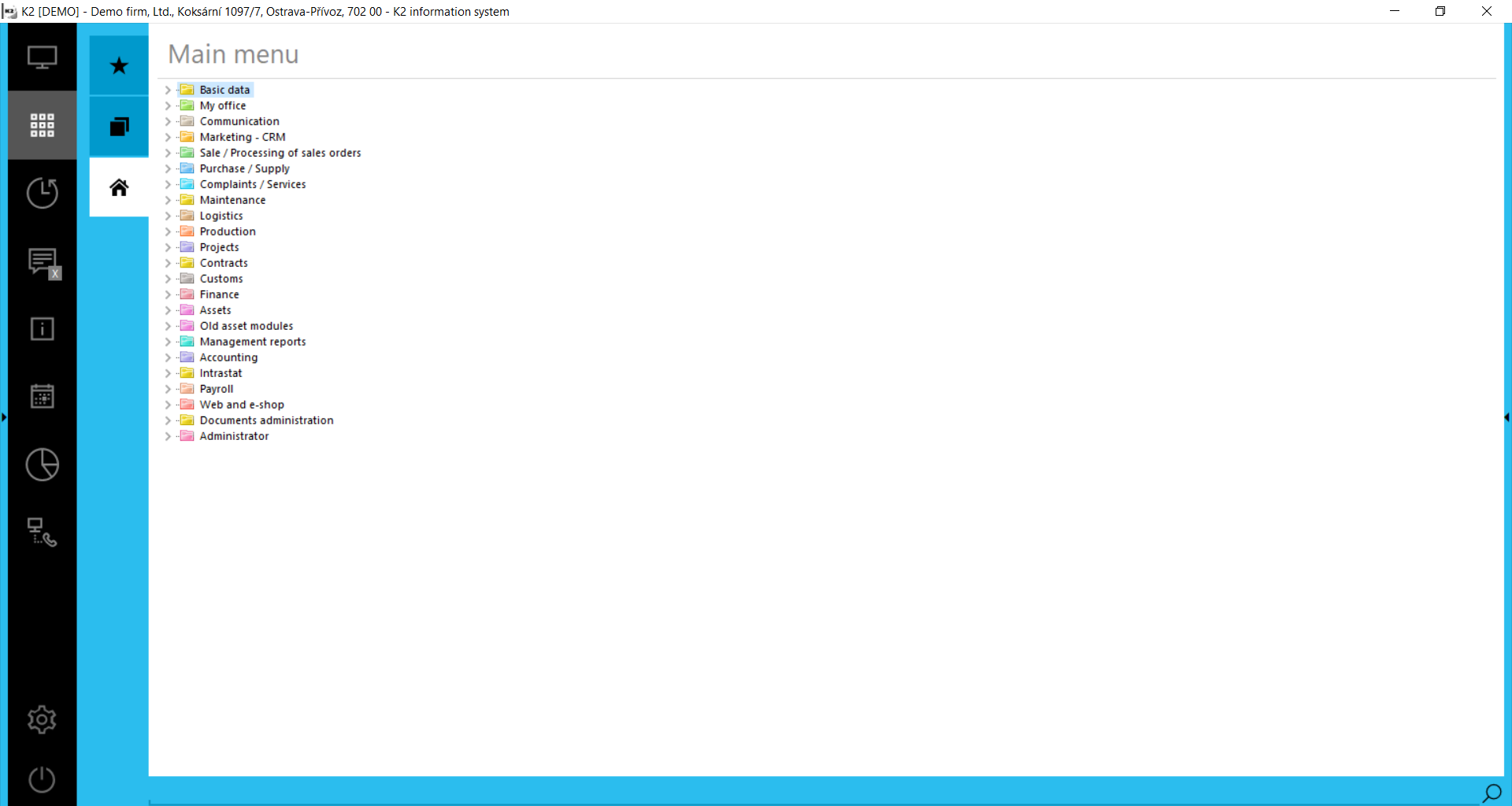
Picture: Desktop - tab Menu tab
The description of working with the tree menu is described in chapter Introduction - Menu system K2 - Tree menu. Principle of work with tree menu items is similar to icons on the desktop, see the next chapter Working with The icons.
Display icons in groups
On Favourites and Default tabs, the icons can be grouped according to which module they belong to. To grouping, use the Show groups button marked in red box in the pictures below.

Picture: The Display groups button - not grouped icons

Picture: The Display groups button - grouped icons
Part of the main area is also the search field (in red box) - a more detailed description is in chapter Search.
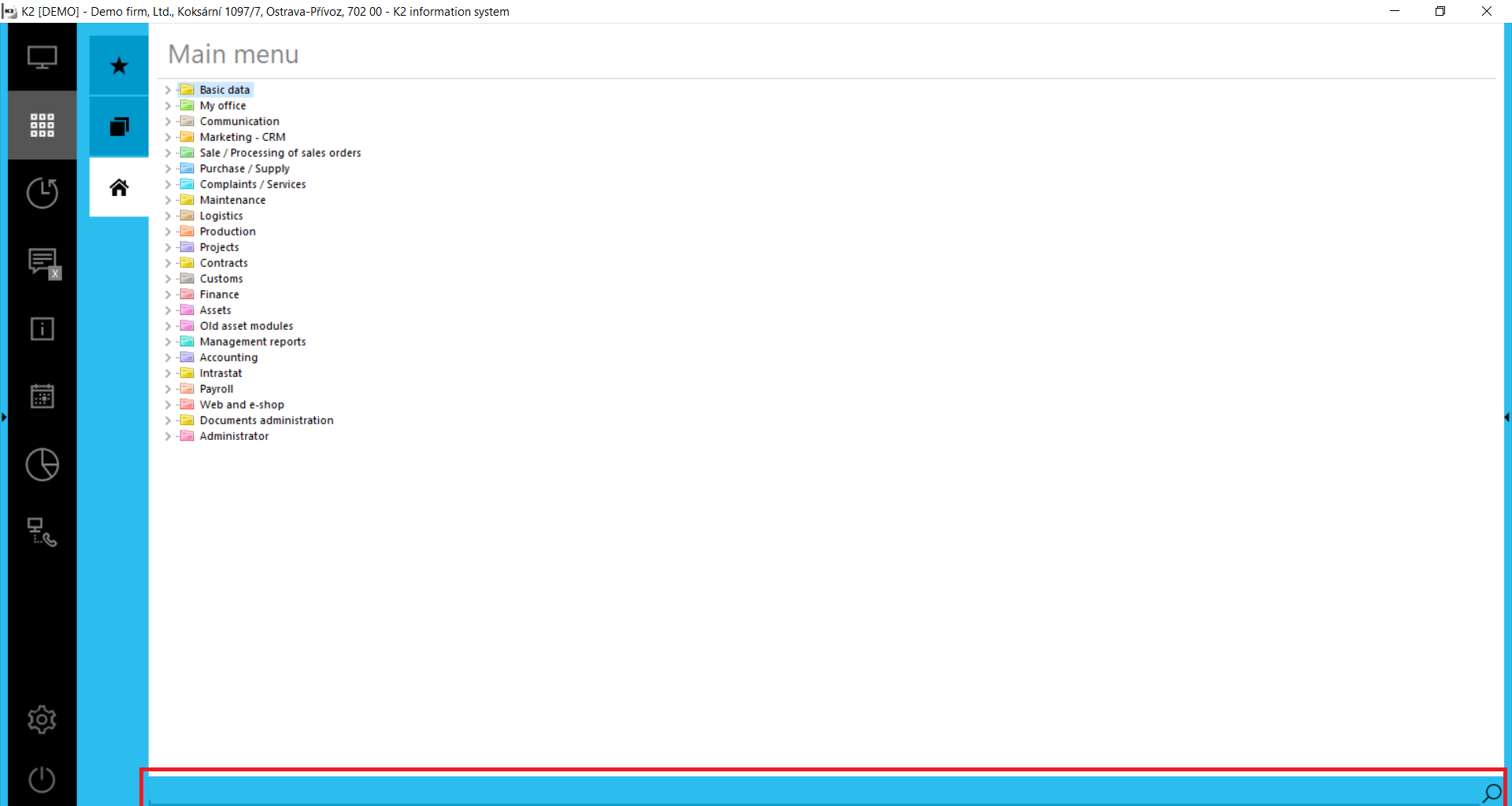
Picture: Desktop - search filed
Working with icons
You can edit your desktop design according to your requirements. Tabs from individual parts of the desktop can be set or copied in within these parts. You can also set Desktop design that was in the elder versions of the K2 IS.
The existing icon on desktop - Default tab
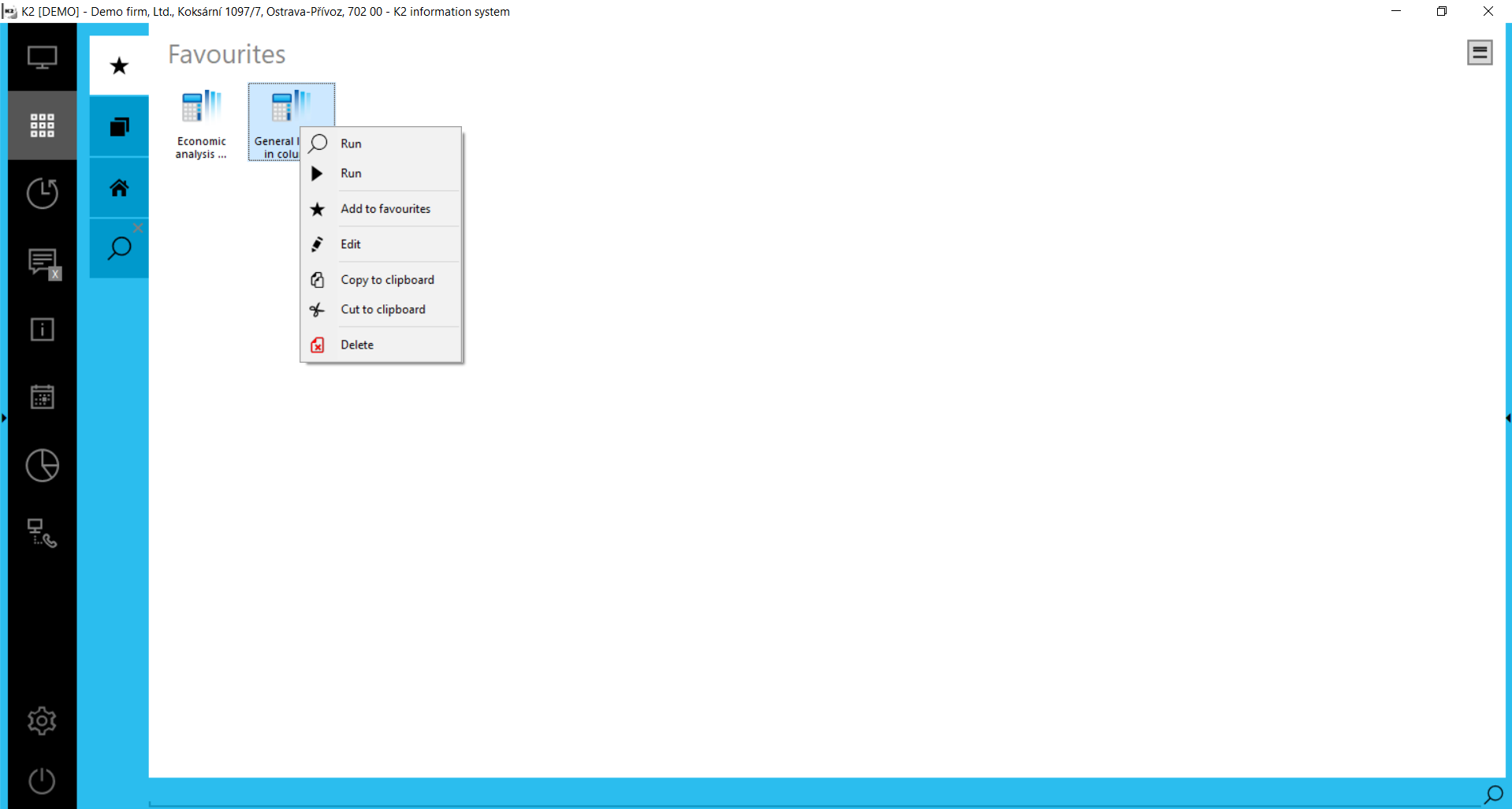
Picture: Desktop - possibilities
Description of functions:
Run |
It runs the function (e. g. It opens the book or it display the report). |
Run in a new window |
It runs the function in a new window. |
Run in a new tab |
It runs the function in a new tab in the middle part of desktop. |
Add to Favourite |
The function is add into the Favourites tab as an icon. |
Properties |
This item displays the properties of the saved icon. |
Copy |
It copies an existing icon from the Favourites, Default or Menu. Then you can paste it anywhere on the desktop in the Favorites tab. You can edit this new created item, e. g. you can edit the name, parameters, view, etc. You can copy this icon by pressing Ctrl+C keys. Further possibility for copying the icons is by the "drag&drop" function from the Default tab or Menu onto the Favourites tab. |
The same book can not been opened twice by repeated double pressing the left mouse button - it spares space. If you want to open the book more times inthe tab, you have to use the function by pressing right mouse button and by selection the possibility Run in a new tab.
The existing icon on desktop - Favourites tab
The Favourites tab is determined only for use of a user, every user can edit it according to his/her requirements. It contains more options than the Default tab.

Picture: Desktop - possibilities - for Administrators
Description of functions:
Edit |
By means of Edit option, it is possible to modify the individual icons setting. |
Note: In case that you have set Your Desktop, see the Setting desktop chapter, the dragging icon means moving it!!! If you want to copy the icon, you have to press the Ctrl key during dragging!
Remove |
The function is similar to copying but the icon is not copied but it is removed. You can remove the icon also by pressing Ctrl+X keys. |
Delete |
Deletes the icon from the desktop and also the item from the tree menu. You can delete also by the Del key. |
The meaning of other functions is the same as in the Default tab.
All these operations with icons can be executed with more icons at once:
- by clicking on heading of "group", e. g. "Marketing" (groups are ordered alphabetically on the desktop),
- by selecting the icons by keeping the left mouse button on icon and parallel moving the mouse indicator through the others icons,
- marking the icons by pressing the left mouse button on icons one by one with the pressed Ctrl key at once,
- marking of icons by means of arrows on keyboard with the pressed Shift key at once.

Picture: Desktop - group on the Default tab
Insert Icon - Favourite tab
You can insert icons only on the Favourites tab. You can add the icon by pressing Insert key or by pressing the right mouse button on desktop of Favourites tab. If you select the New item, you can choose if you want to insert e.g. a new book or report.
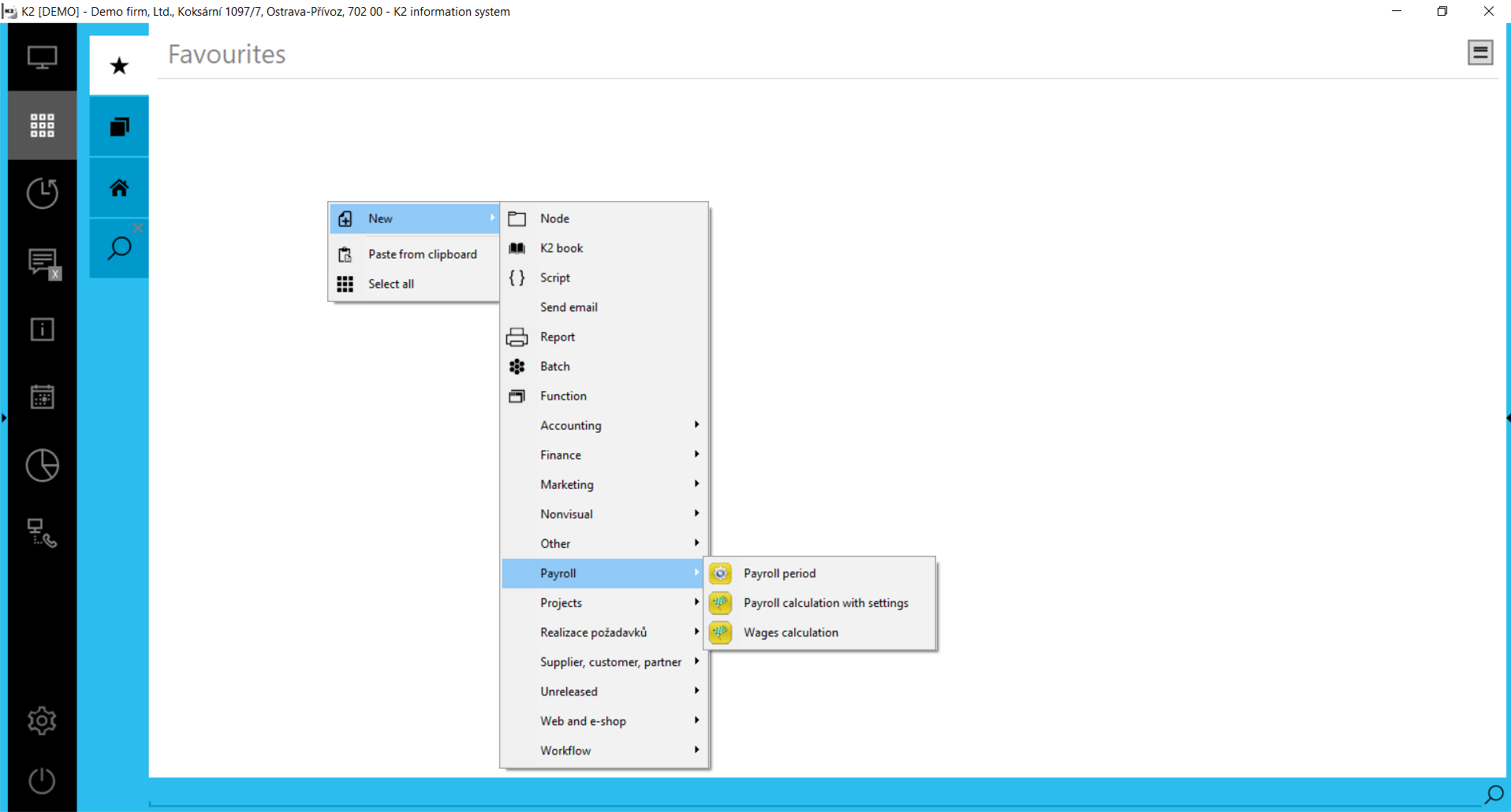
Picture: Desktop - Favourites tab - insert icon by pressing right mouse button
Description of functions:
New |
It inserts new book, report, script, function or picture, etc. |
Paste |
On desktop, you can paste an icon that you have copied or cut from Favourites, Default or Menu. Insert by pressing Ctrl+V keys. |
Select all |
It indicates all icons on the tab. |
After pressing the New or Ins possibility the form for inserting a new function displays.
Description of shared fields of form for all elements of desktop and tree menu:
Name |
Name of item in the tree menu. |
Icon |
Select a bitmap that will be the icon for desktop of the K2. |
Icon for tree |
Select a bitmap that will be the icon for tree of the K2. |
Group |
Name of group in that the icon will be assigned on the desktop of K2. |
Tip |
Into this field, we enter text which will then appear as “hint” atthe element. |
Book
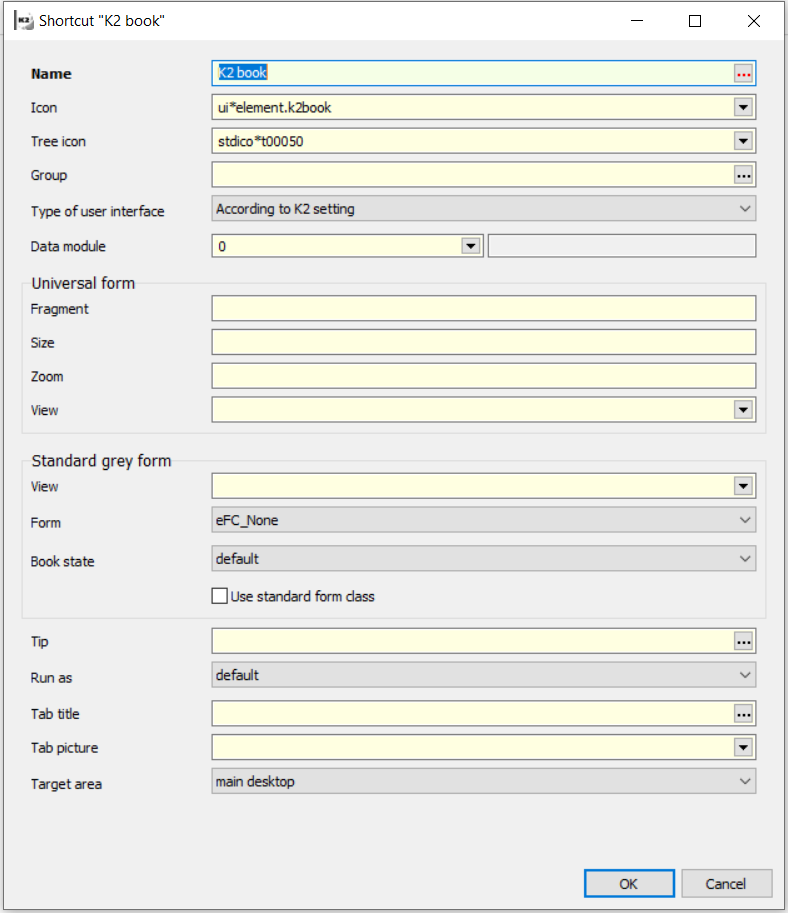
Picture: Form for editing book
Fields of book Description:
Data module |
Select a book over that the function will be run. |
Form |
It is automatically entered after selection of data module, but you can change it by selection fromthe expanded menu. |
View |
You can select already saved view in data module. The function will be run in this view. |
Book status |
Select the status of book in that the book will be run (in the filter, or over all records or in default setting). |
Run as |
You can run this function either as the tab or as a new window or in a default setting. |
Title of tab |
The name of a new tab in that the function is activated. |
Picture of tab |
Option to select a bitmap that will be represented a new tab. |
Target area |
The part of desktop in that the function is saved (desktop, navigation, notification or default setting). |
Batch
It is used to activate more functions one after another. E. g. firstly, you can set the selection to be run. Next functions will take the selection as a current data module. You can also insert a batch into a different batch. Every report can have it's own data resource.
Batch tab
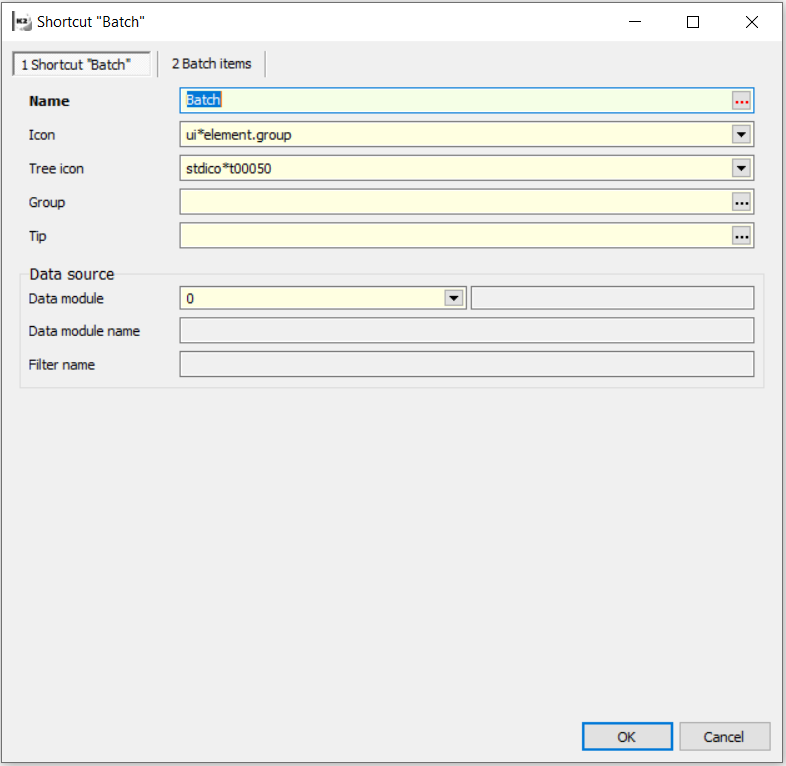
Picture: The form for batch setting
Field Description:
Data module |
Define the data module over which the batch is to be activated. |
After filling in the Data Module field on the form for batch definition, another field Filter will appear.
Filter |
Field for the selection of an existing filter of the selected data module. |
Use superior data module |
This field enables reports and scripts to get current data module either as a data module defined in the Data source or, if possible, the data module that is currently active inbook - without edits. |
After expanding the Filter field, a list of filters saved in the given data module will appear. Selecting a filter ensures that the item of a batch (e.g. a book or a report) will be run over the records selected by the defined filter.
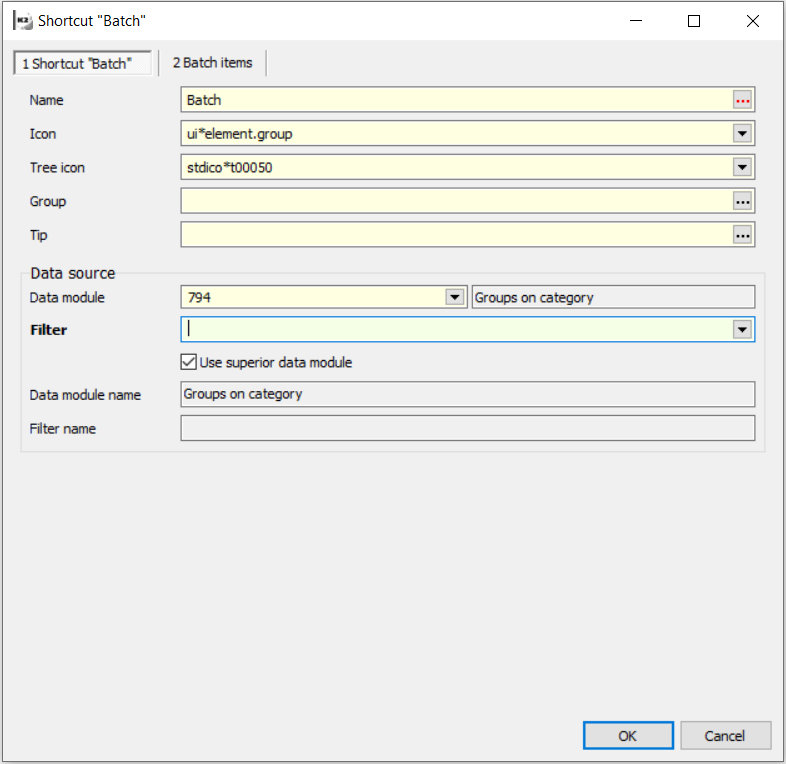
Picture: Form for batch settings - Filter field.
Items of batch tab
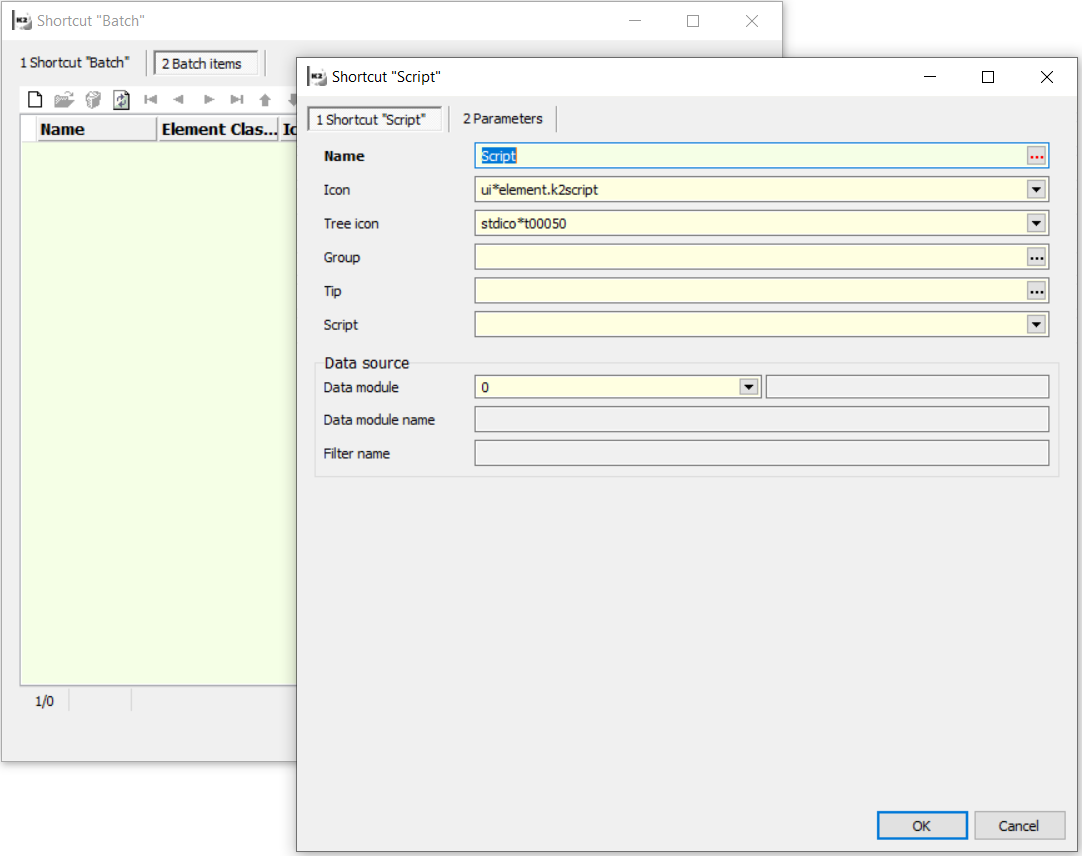
Picture: Form for setting items of batch - script
When insertion a new item of batch the form opens depending on selection of type of function. E. g. on the picture there is displayed a form for insertion of a script into the batch. The script is identical to form for adding a script to the desktop or to the tree menu.
Report
Report tab
Report that is activated from substitute or from tree menu is opened as a new tab. Report that is activated through the Reports (F9) book is opened in a new window. The report is activated on an active data module (on an opened book) that is activated on a middle column.

Picture: Form for inserting report - Report tab
Field Description:
Report |
Select report from directory. |
|
Run as |
Way how the report will be activated, e. g. in a new window. |
|
Electronic signature |
|
|
Sign |
Field can obtain the values Never,Alwaysand If signature is entered. |
|
|
Never |
The report is always printed without a signature. |
|
Always |
The report is always printed with asignature. This value is conditional on the certificate being installed and filled-in either in the Signature field or in the report parameter ("Sign"). If it is not, an error message will appear while printing out the report. The report will not be printed out without the electronic signature. |
|
When the signature is specified |
The report is always printed. If the certificate is entered in Signature field or in the report parameter, then the report will be printed out with signature, if not specified, will be printed without a signature. |
Signature |
Select the installed certificate from the file. |
|
Name |
Automatically completed certificate name by filename. |
|
Data source |
|
|
Data module |
Data module over which the batch is to be activated. |
|
Filter |
The field works similarly as in abatch. Batch |
|
Use superior data module |
The field works similarly as in abatch. Batch |
|
Printing settings |
|
|
Printer |
Printer by that the report will be printed. |
|
Copy |
Number of copies. |
|
Sorting |
It works simultaneously as "Completion" at settings printers. When printing more documents, the sheets of paper will be ordered in a row like in individual documents. (First, second, third,... page; First, second, third,... page) |
|
Print on both sides |
The document will be printed on both sides. |
|
Rotated pages |
Report will be printed to enable browsing pages from below to the top. |
|
Paper resource |
Resource of paper that will be used to take paper for printing. |
|
Export settings |
|
|
Target of Export |
Select where you want to print the report, e. g. into the e-mail. |
|
Format |
File type, in that the report will be saved. |
|
File name |
Name of file, under that the report will be saved. Note: When sending a report via email, we do not fill in the file name. |
|
You can send the report by e-mail. Set the e-mail, subject and text of message. |
||
Title of tab |
In case that you open the report in a new tab, enter a name of the tab here. |
|
Picture of tab |
Option to select a bitmap that will be represented a new tab. |
|
Target area |
The part of desktop in that the function is saved (desktop, navigation, notification or default setting). |
|
On the Parameters tab set the parameters of report.
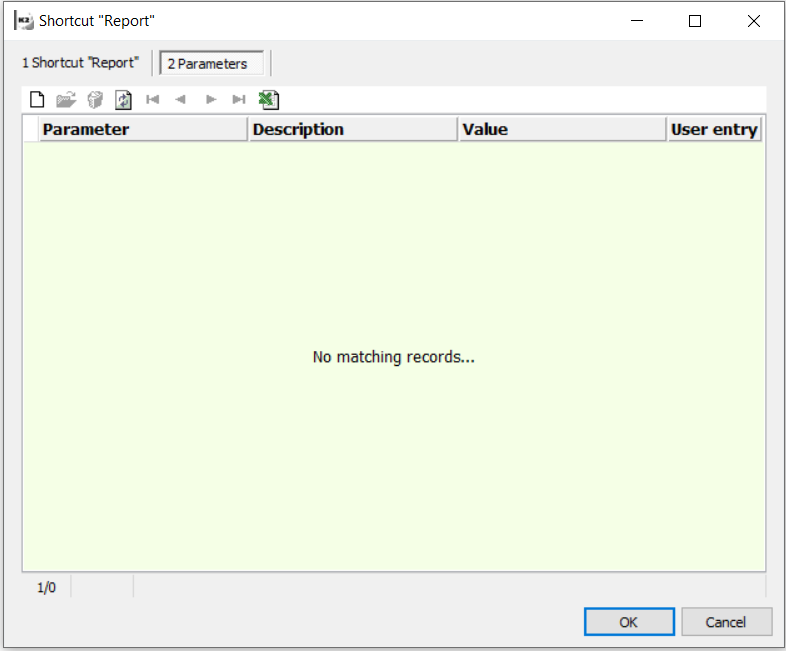
Picture: Report - list of parameters
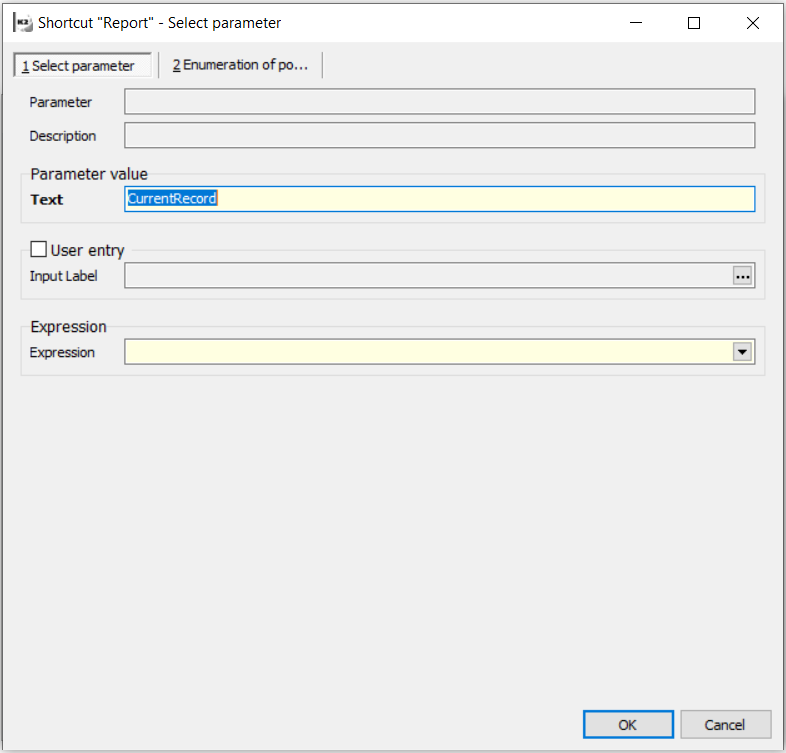
Picture: Form for setting parameter
Description of fields of the form for setting parameters of report:
Parameter |
Program parameter name. |
Description |
Parameter's description. |
User description for manual input |
The field is meaningful if the User input field is checked. Here you can define the label that will be displayed at the parameter when activating the report. |
User input |
If the field is checked, then when activating the report, the form is displayed to set the values of parameter. |
Value Yes / No |
If it is checked, the value is set on "Yes". |
Expression |
|
Script
Script tab
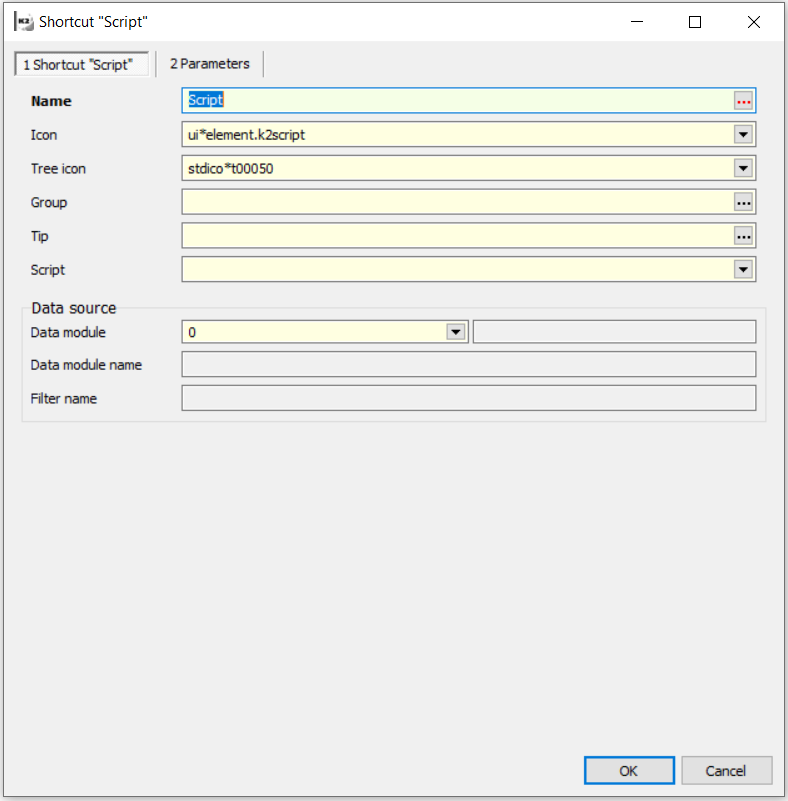
Picture: Form for insertion of script - Script tab
Field Description:
Script |
Selection of script from directory. |
Data module |
Define the data module over which the script is to be activated. |
Filter |
The field works similarly as in abatch. Batch |
Use superior data module |
The field works similarly as in abatch. Batch |
On the Parameters tab set the parameters of script.
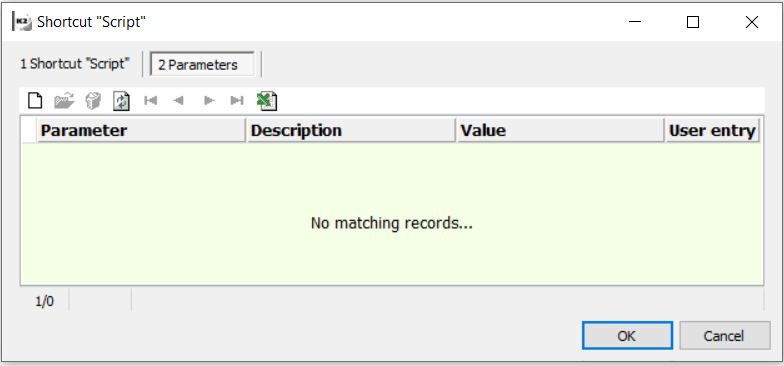
Picture: Script - list of parameters
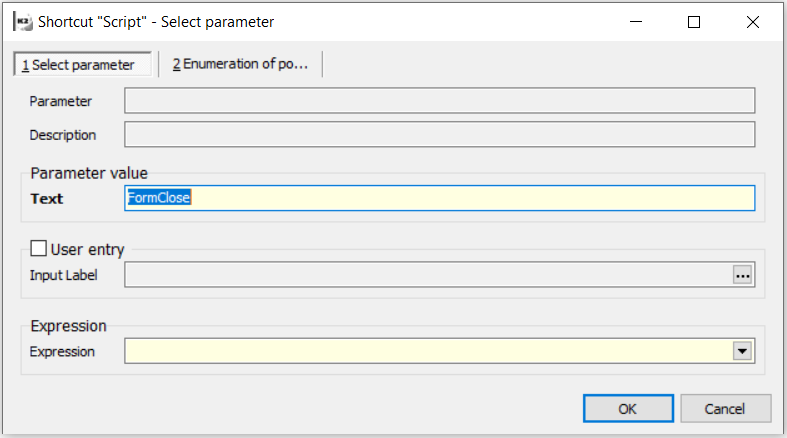
Picture: Form for setting parameter
The functionality is similar to setting the parameters of report.
Function
Not all functions are book, report or script. Here you can set the other functions.
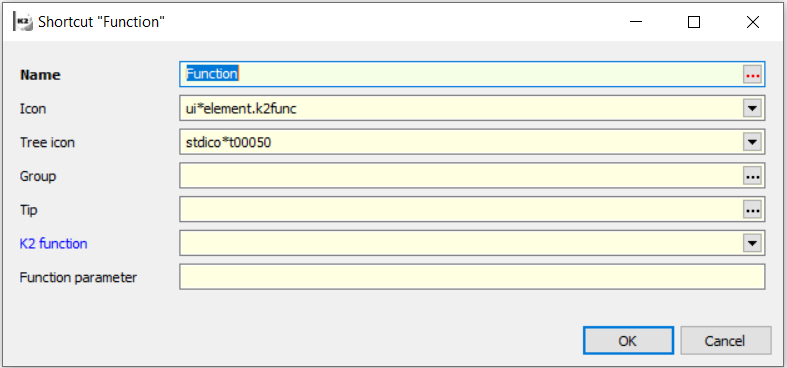
Picture: Form to insert the function
Fields of function Description:
No. of K2 function |
Select the demanded function from the code list of registered functions. The number of function is entered. |
Nonvisual
This item includes the functions: Batch, Script, Report, Product recalculation, Stock recalculation and Stock recalculation - current period. These functions are run in the background (we do not see their progress). They are used, for example, in Task schedulers when they run automatically for some time. The settings for the Batch, Script, and Report functions are the same as Setting Of visual functions see further. The functions Products recalculation, Stock recalculation and Stock recalculation - current period are described in the next chapter called Standard actions. Task scheduler
Other
Form of script
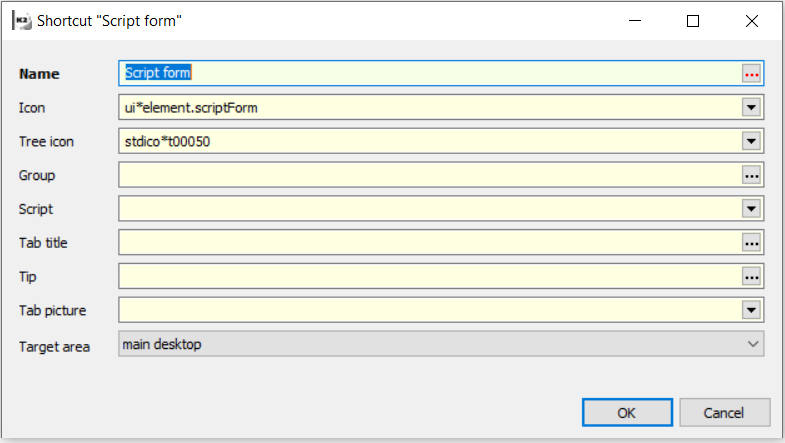
Picture: Form to insert a form of script
Description of fields of a form of script:
Script |
Path to select file of form of script. |
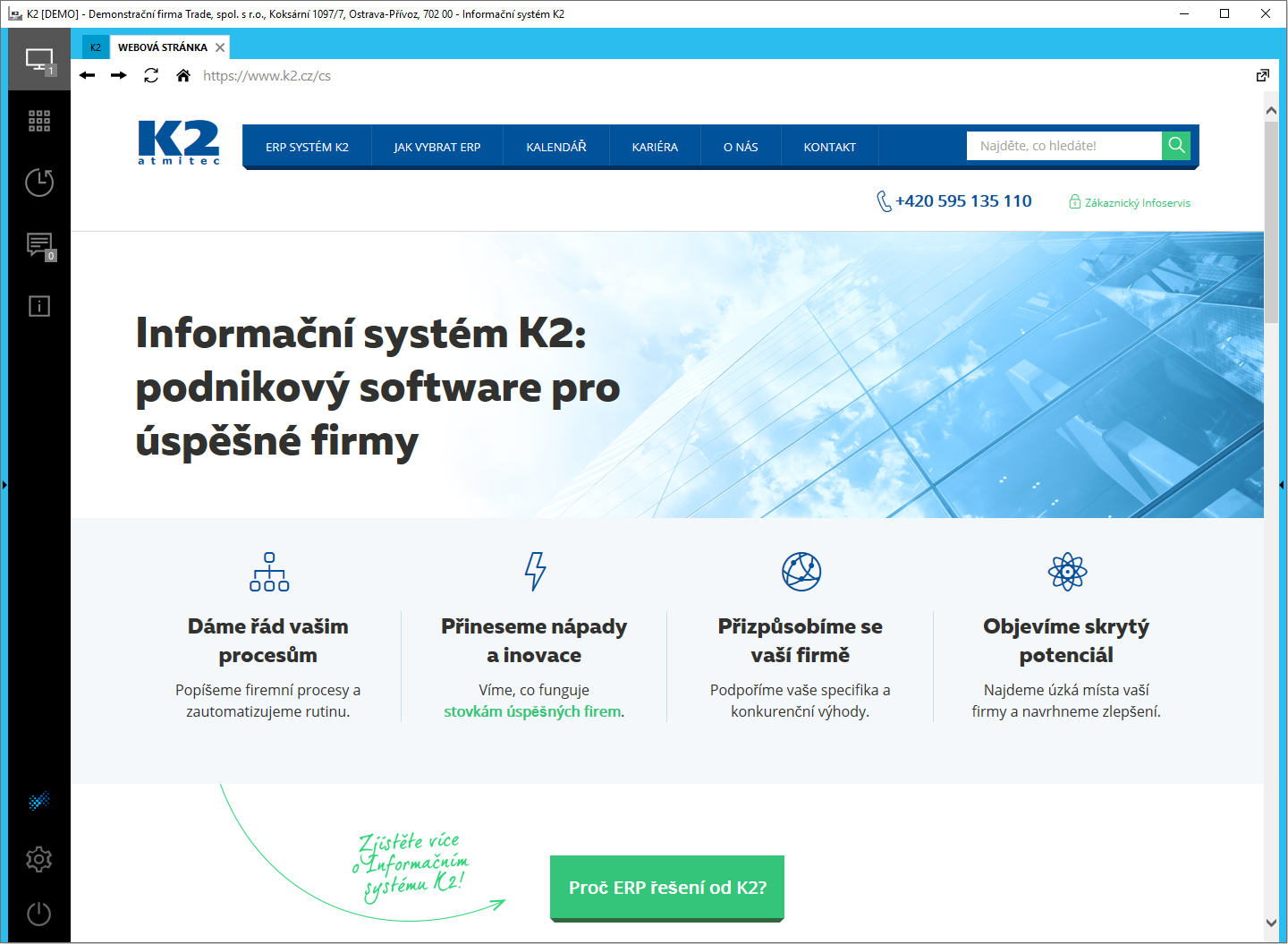
Picture: Web page - navigation
Web page
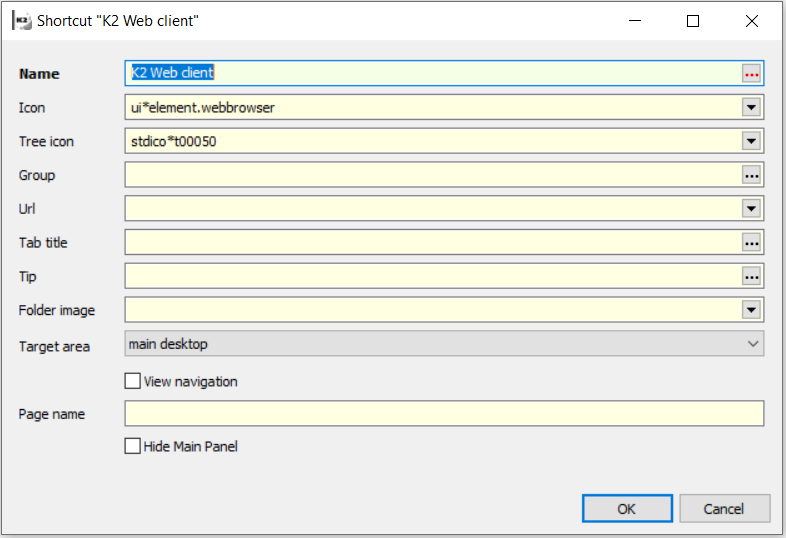
Picture: Form to insert a web page
This operation requires very good knowledge of the script.
URL |
Domain address of server. Part of a web address is an address, at which the web client is installed. Part "/default.aspx" has to always be given at the end of the address. It displays the default page of a web client. |
View navigation |
If you check this field, a navigation to switch back and forward between webpages, to refresh the page and to switch on the home page will be displayedin the Internet Explorer browser. Navigation is marked by a Red box on pict.: Web page - navigation". |
Picture
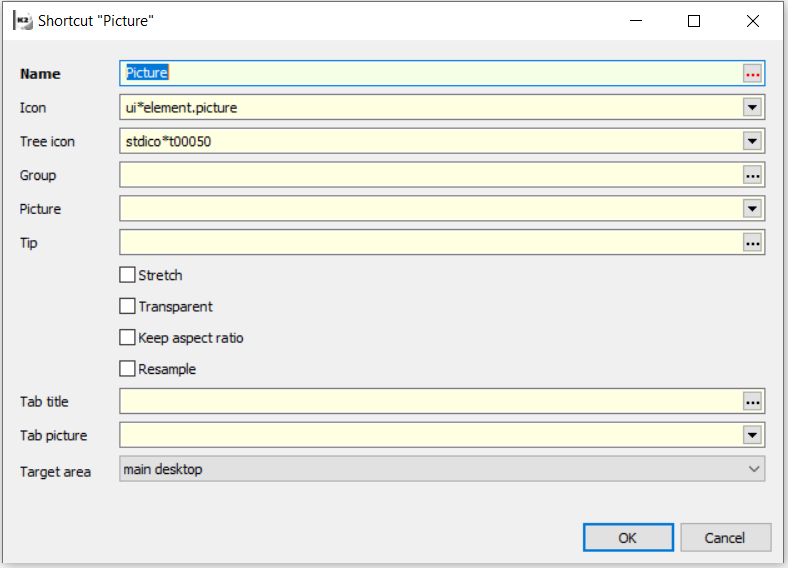
Picture: Form for editing picture
Fields of picture Description:
Picture |
Path to select the picture from directory. |
Presentation of pictures

Picture: Form to insert a picture slideshow
Description of fields of the Picture slideshow form:
Path |
Path to select the presentation from directory. |
Interval of change |
Time in that the snapshot in presentation will be changed. |
Olap
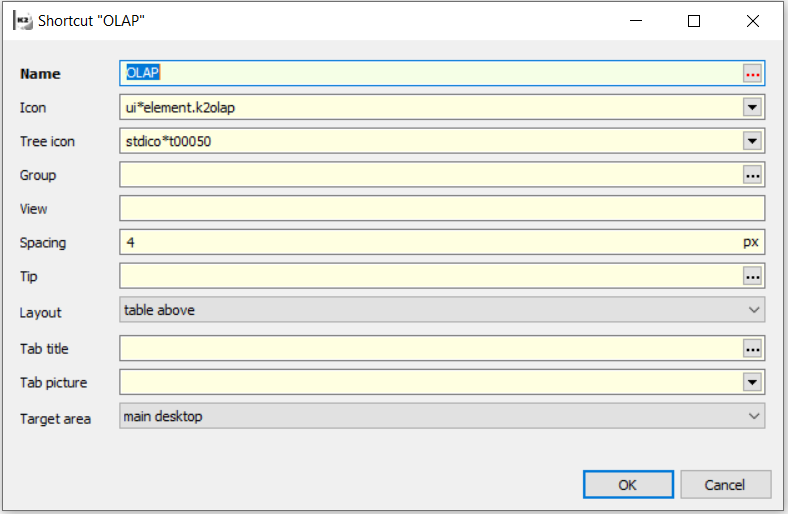
Picture: Form to insert the Olap item
Description of fields of the OLAP form:
Spacing |
When a table and a chart are displayed, we can specify here, how manypixels they will be separated from each other. And either horizontally or vertically in n dependence on thesettings of the field Layout. |
Layout |
If it is going to be a table or graph and where they are going to be placed (only table, only graph, table left, table right, table up, table bellow). |
Menu tab
Existing folder or function in tree menu
Folder

Picture: Tree menu - options of folder
Description of functions:
Properties |
This item opens the form with properties of the selected node. |
Copy |
The existing node is copied and subsequently you can insert it anywhere on the Favourites tab. You can edit this new created item, e. g. you can edit the name, parameters, view, etc. You can copy this folder by pressing Ctrl+C keys. |
Function
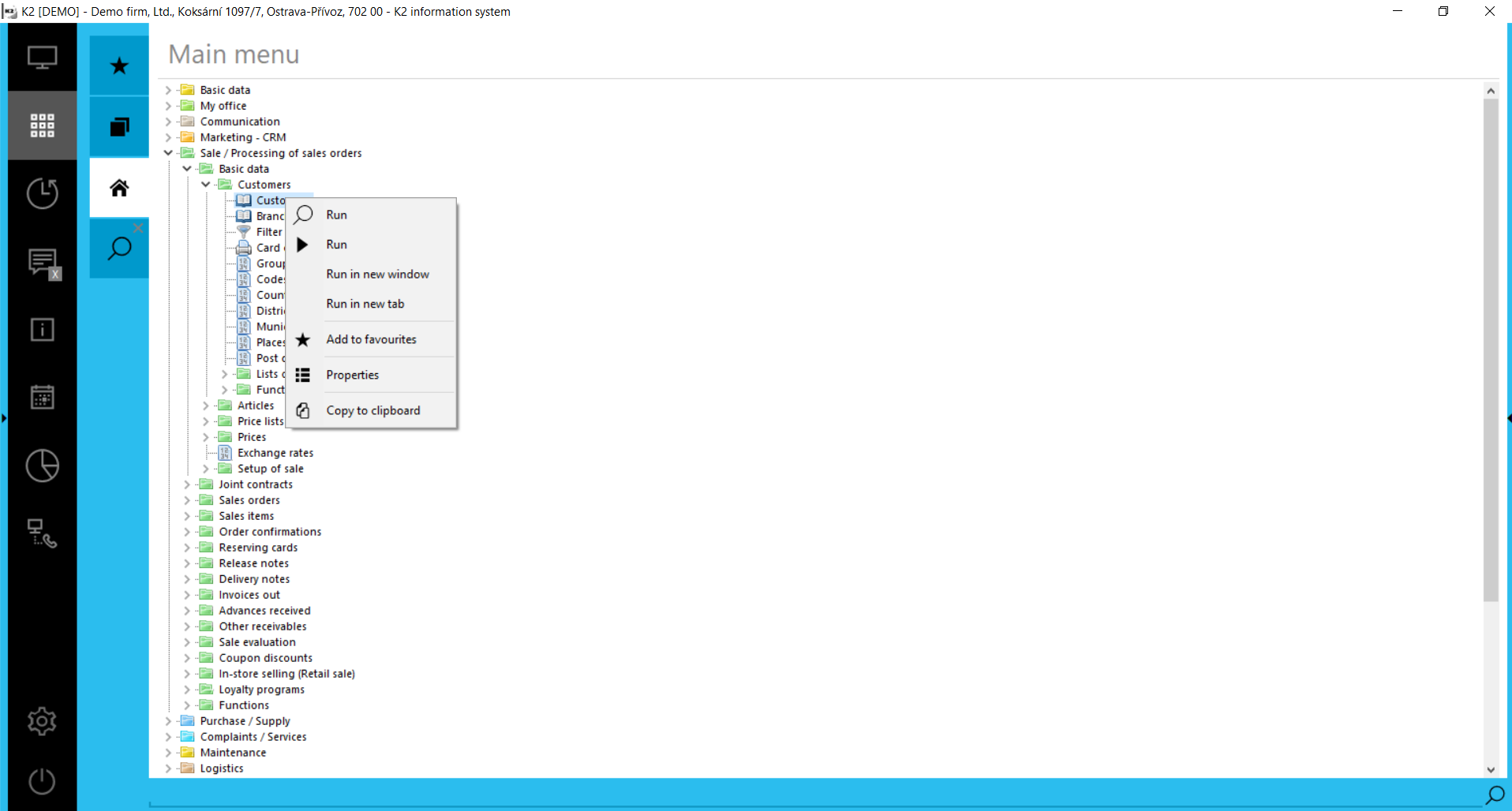
Picture: Tree menu - options of function
Functions work simultaneously like on the Default tab.
Desktop - navigation panel
The notification panel shows all received notifications (= notifications). Its functionality is described in the Notifications chapter.
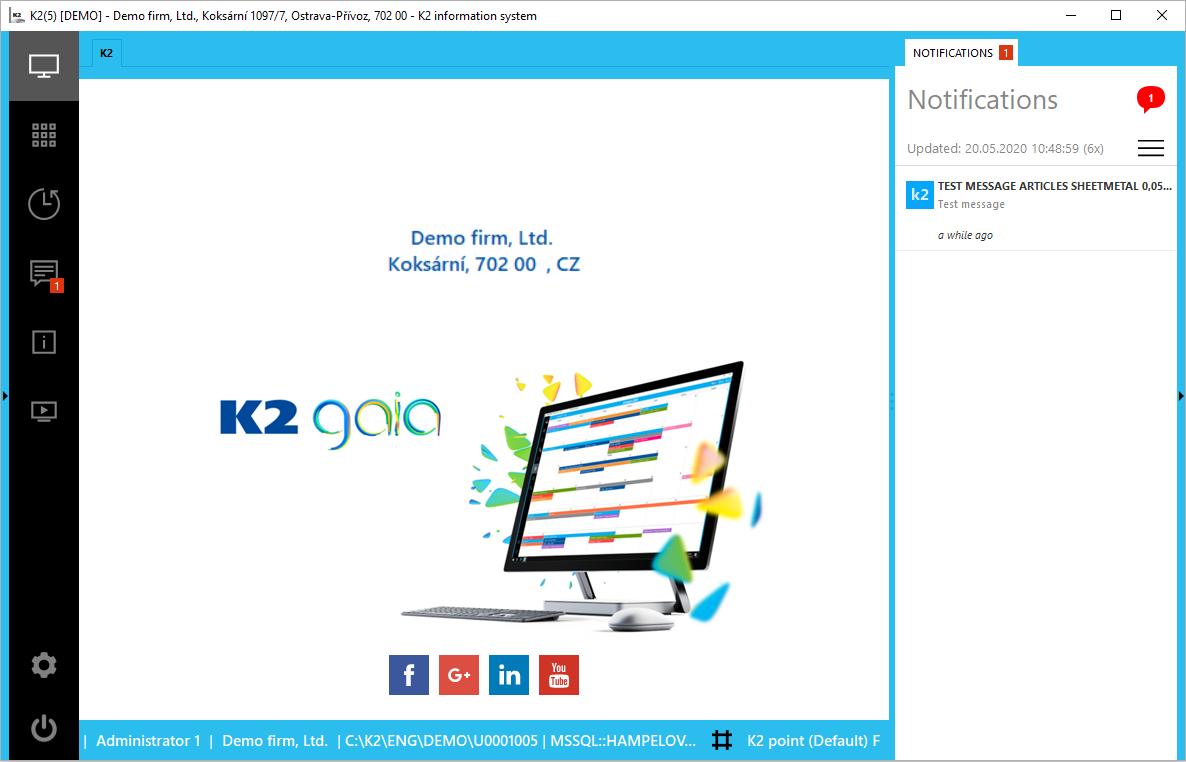
Picture: Desktop - notification panel
Desktop administration
K2 Desktops
When setting desktop you can select a desktop from existing ones (Economy, Pay rolls, Business, Reclamation/Service or you can switch on Default back) or you can save your own setting desktop.
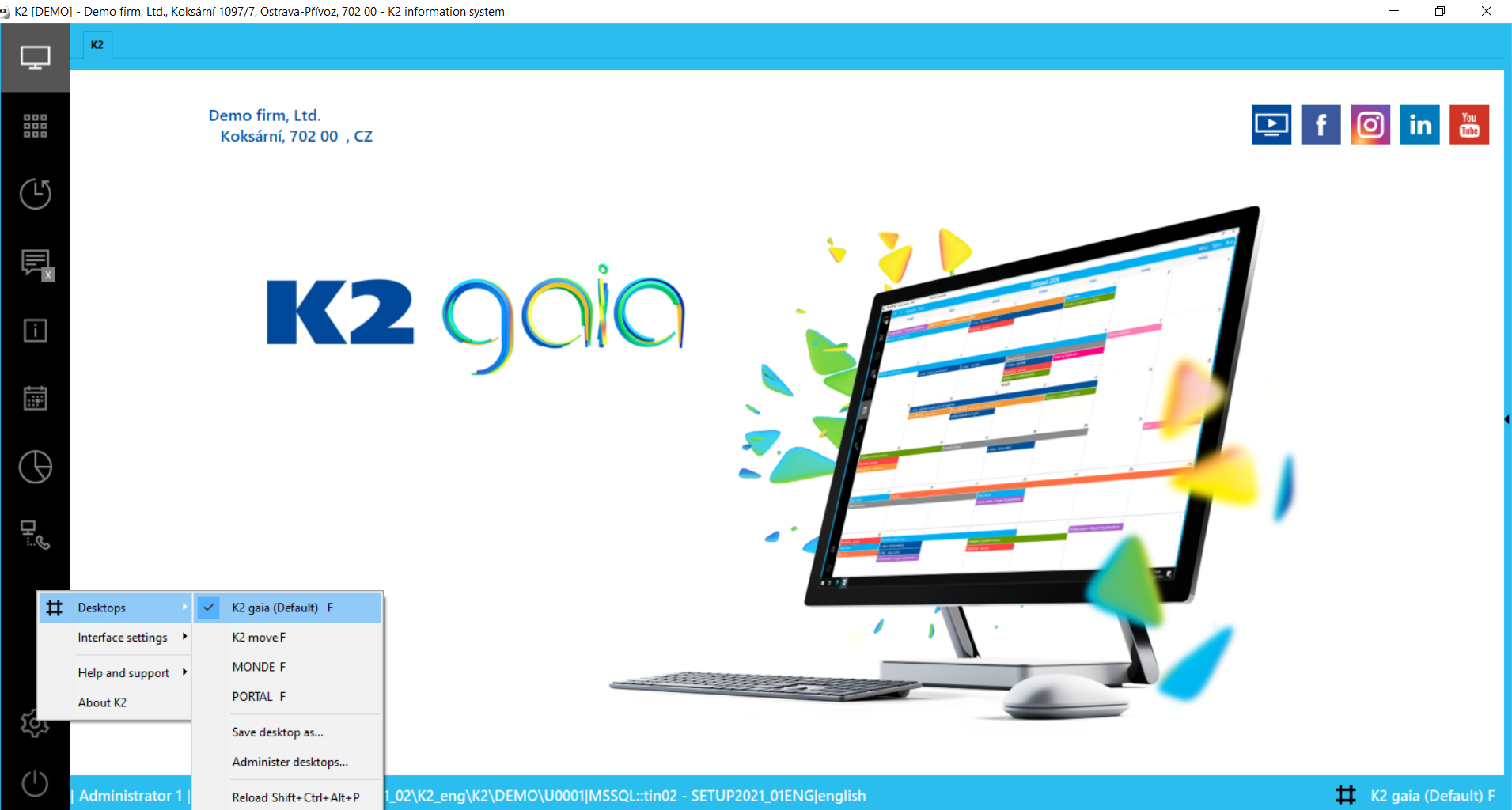
Picture: Desktop settings
If you set the desktop according to your requirements, you can save it. The Save desktop as option is used to do that.
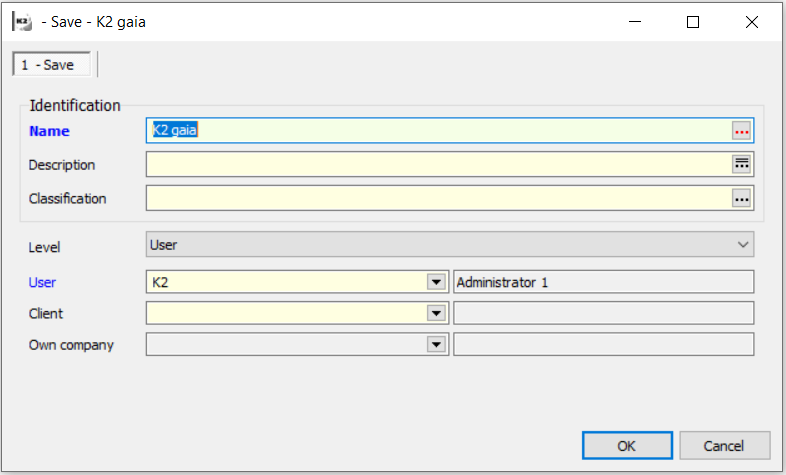
Picture: Save form
Description of functions:
Name |
Name of a new desktop. |
Description |
Description of a new desktop. |
Level |
Conditions' setting for search is identical with the conditions setting of the evaluating filter.
|
User |
Select name of user from book of users. |
Client |
Select a client for who you want to save the selection. |
Note: Attention, the message, if you want to save changes ondesktop, does not appear before you close the K2 IS! desktop.
You can edit your own saved desktop.

Picture: Desktop settings
Change default desktop
Whether you select a preset desktop or create your own, you can set the desktop as "default". You can change it in the menu Desktops - item Set current desktop as default for "DEMO" client. In The client to which we are currently logged will be automatically added in the quotation marks. Only the area that is saved as "factory", "global" or for a client can be set as "default".
Only the user with Service Interventions (Administrator / General) can change the desktop.
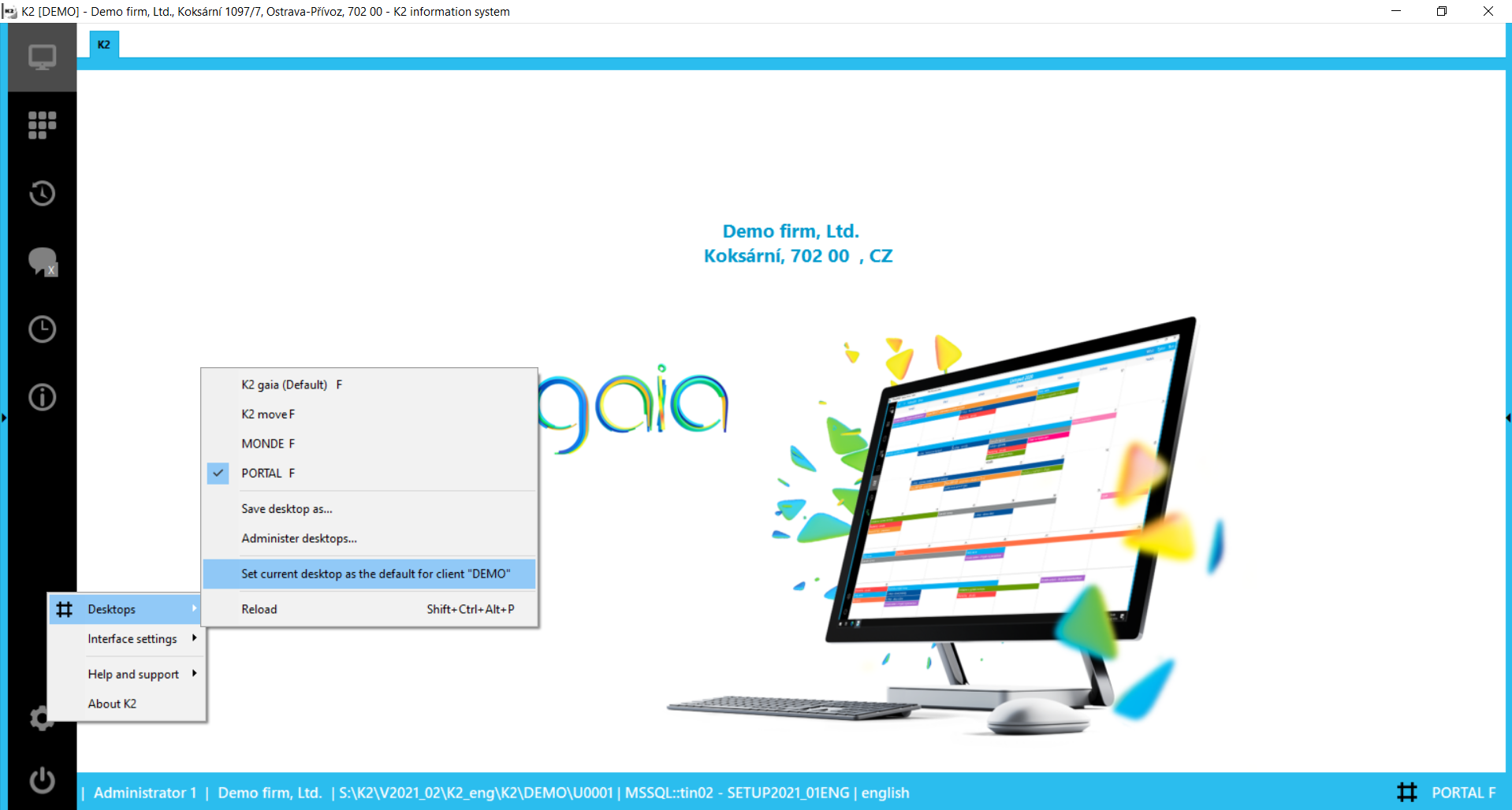
Picture: Set desktop called Economy - the option to set the desktop as "default"

Picture: Desktop Economy is set as "default"
Description of functions:
Desktops |
List of saved desktops. |
Load (Ctrl+Alt+Shift+P) again |
The Reload function is used for re-loading desktop into the state when it has been saved at the last time. It is important that this function does not change the contain but only the setting. E. g. You have added a new icon onto a desktop and changed colour of desktop' background. If you run the Reload function, the icon is not deleted, but the colour of desktop' background is set back into the original setting. |
Save desktop |
Save a current setting of desktop. |
Save desktop as |
Save the current setting of desktop as a new desktop. |
Administrate desktops |
The form opens with list of all saved desktops. You can edit your desktop after opening it. |
Edit desktop |
The form to edit desktop opens. |
Re-colouring |
Here you can change setting of colours of individual components of desktop. |
Other possibilities of own desktop
Menu for inserting a new tab is larger on the "own" desktop than "default" . We can put the same elements into the tab as we put in the shortcuts. In addition, there is, for example, a text or a list of notifications displayedin the Notifications toolbar.

Picture: Possibility to insert a new tab on the "own" desktop
Shortcuts in this desktop and Favourites
In the "own" desktop you can put a tab of the Shortcut type in this desktop or Favourites (marked with a red frame in the picture above). Both types enables to insert Shortcut toolbar or Shortcut tree. You can insert shortcuts (icons) according to your own requirements on the shortcut toolbar, either by pasting a new icon over the right mouse button or by copying an existing one from other tab. Like the Shortcut toolbar, you can paste a new tree or copy an existing one into the Shortcut Tree.
Shortcut in This desktop are remembered only in K2desktop, where you insert these shortcuts.
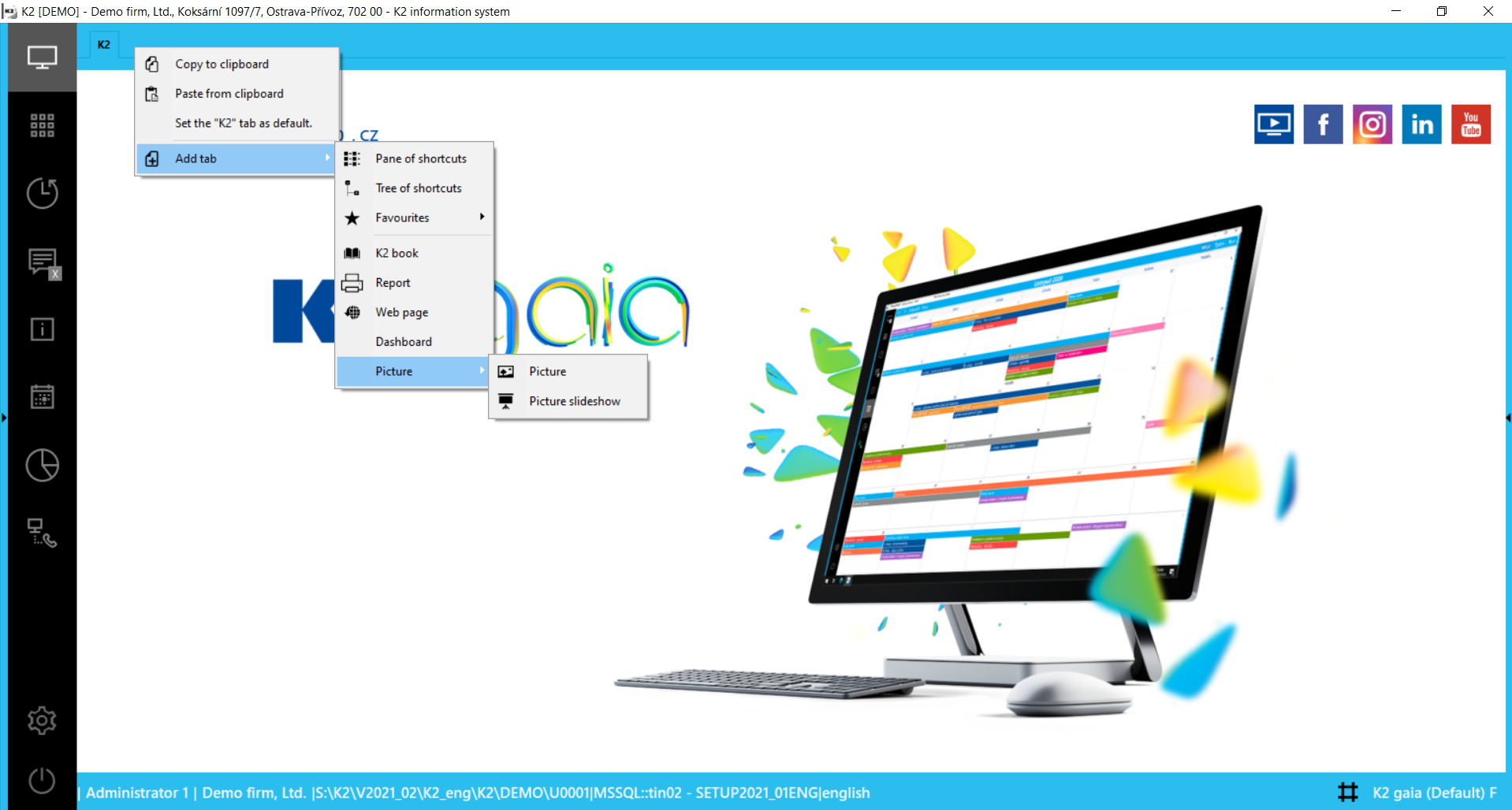
Picture: Shortcuts in this desktop
Favourites - shares the tab contents among the other users, clients etc.
Description of tab types:
Shortcuts for users |
The tab and its contents is visible only for the user who has inserted the tab, regardless of which client he/she is logged in. |
Shortcuts for Users on the client |
The tab and its contents is visible only for the user who is logged on other client. |
Shortcuts for clients |
The content tab can be accessed by any user who logs in tothe client. |
Shortcuts for K2 |
Any user on any client, who belongs under K2, can see the tab content. |
Main shortcuts |
Its contents is the same as the Default tab inthe left column of the desktop. The tab is remembered only within the given area. |
Items of Tree type have similar functionality. The item Main tree has the same contents as the tab in the left column of Menu desktop.
It is also possible to edit the default tabs on the "own" desktop. E. g. this is the K2tab on the Home screen. After you click on the tab by right mouse button, the menu for changing the tab will display (see chapter New tab, described in the chapter Desktop tabs). Therefore, tab can be edited, deleted etc. If you do not save your own desktop, the newly inserted tab with default settings will be unpinned after K2 is closed. The Permanent on desktop option has similar function to the Display also next time except that this tab remains permanently pinned to this "own" desktop. (While Display also next time shows the tab only for that user.)
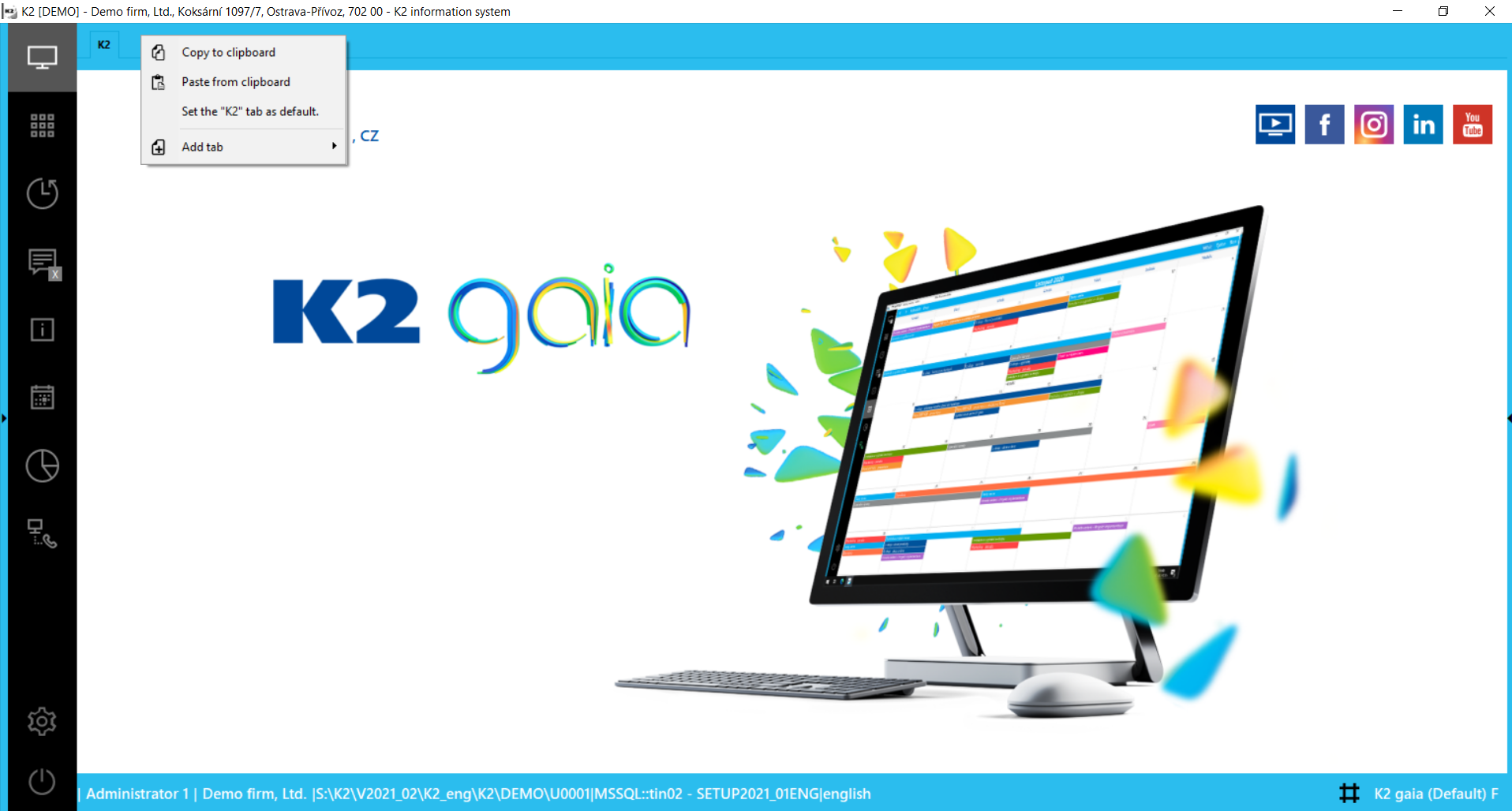
Picture: Own desktop - K2 tab
In the standard desktop, a "pin" is displayed on the tab. This means that the tab is permanently pinned to the currently logged in user and will be displayed the next time K2 is started.
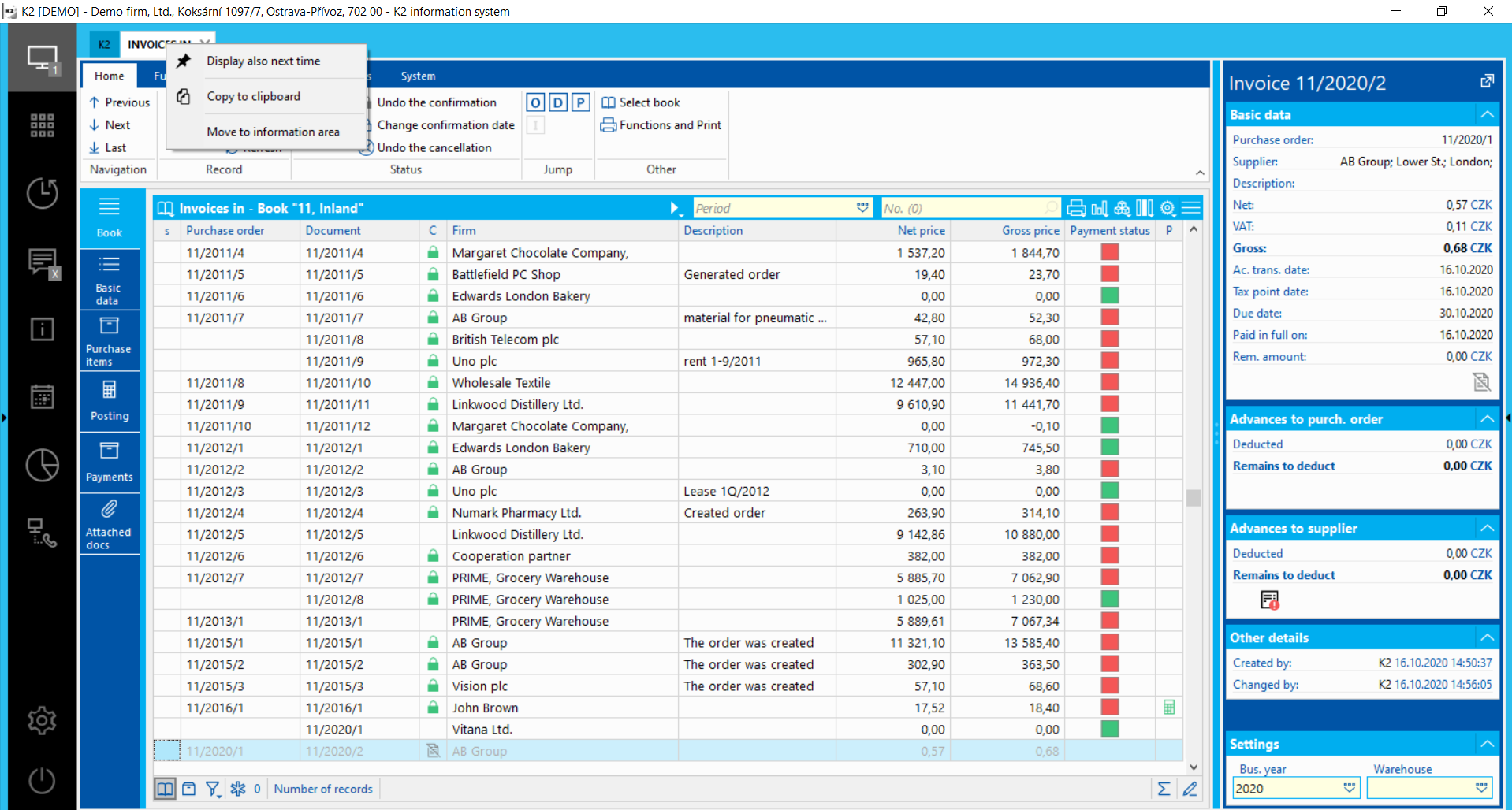
Picture: Default desktop - new tab Invoices In
You can customize the display of tabs on the "own" and standard desktop by clicking the right mouse button on the tab and selecting the appropriate option (see the the chapter Desktop tabs).
All actions can be processed either in the main desktop or in notification panel. It allows you to create a similar desktop to which you are used in older versions of the K2 system, as picture below.

Picture: Settings of "own" desktop
Searching
You can search in Default, Favourite and Main menu tab - according to keyword. Activate searching either by icon of hand glass in row for searching or by Enter key. Searching is executed through tree menu, through shortcuts (icons) and through history. Searching is also available at word connections without diacritics. The list of opened icons will be opened in thethe new tab, then you can open that book or start the function by double mouse click. Then close the tab with a cross (in the blue frame in the picture).
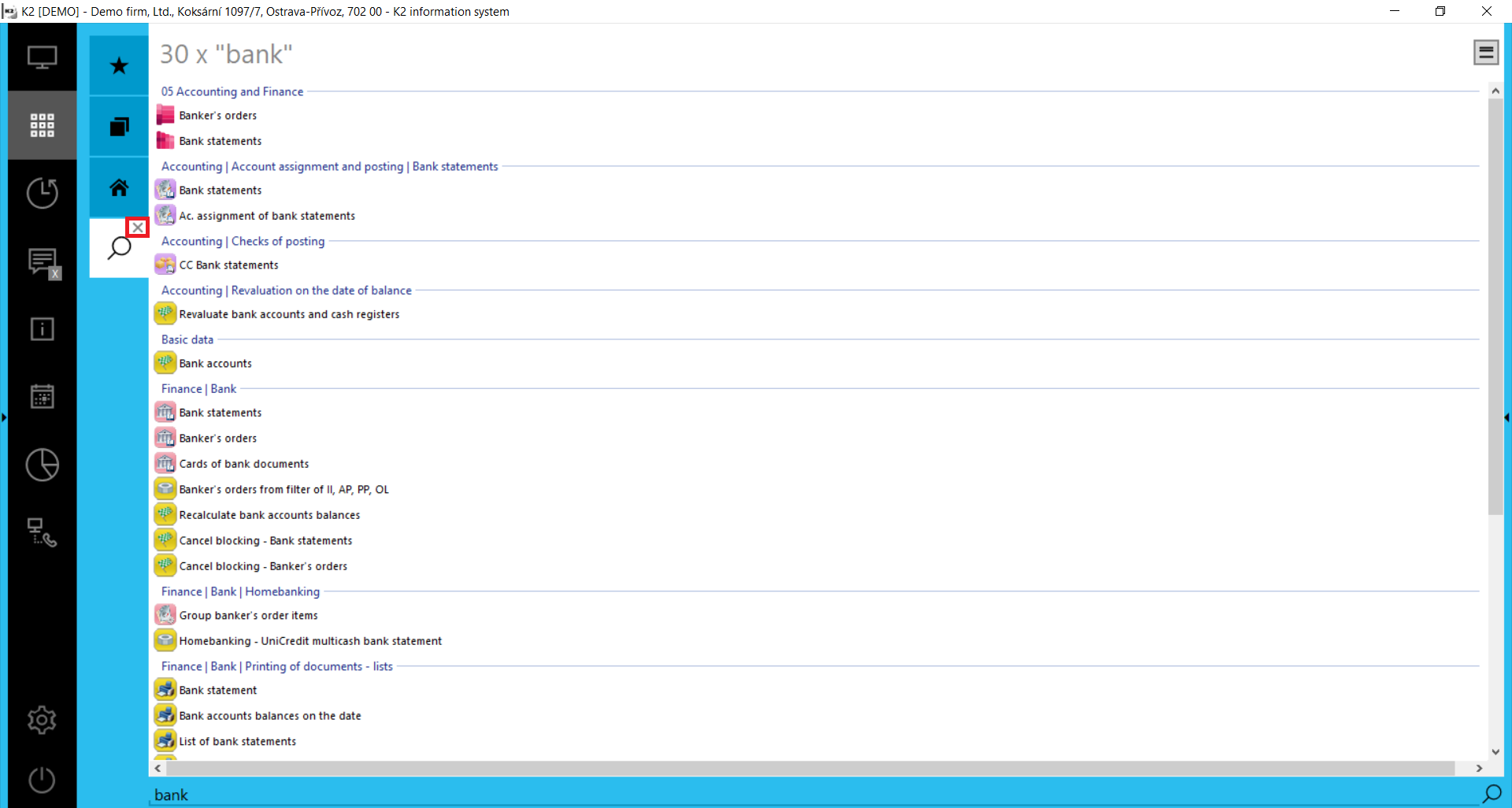
Picture: Desktop - searching
You can also search in reports. If the system finds the correct value, you can switch over directly on a document.
You can switch to the search box from anywhere in K2 using the key shortcut Ctrl+Shift+L.
Classic Forms
Book
A module table is the "zero" page of a module form. There are many shared properties valid for the form as well as for the table (a task bar setting, reports setting, etc.). These settings are not separately defined forevery form, the table included, but they are defined for the whole module.
Articles database (that is a complete line of user's goods and services that are disposable to customers) and Supplier/Customer database (that is a complete list of all user's trading partners) are the master tables (code lists). Filling-in of these code lists is a condition for usability of the K2 program. Loading the data to those tables is the main condition of K2 Programme applicability.
For an example of other tables see e.g. Book of Invoices, Book of Orders etc.. Book is used to Quickly find the item you want and provides Basic information. (The concept "book" is used in connection with "series" of documents e.g. Book (series): 10 - Inlands).
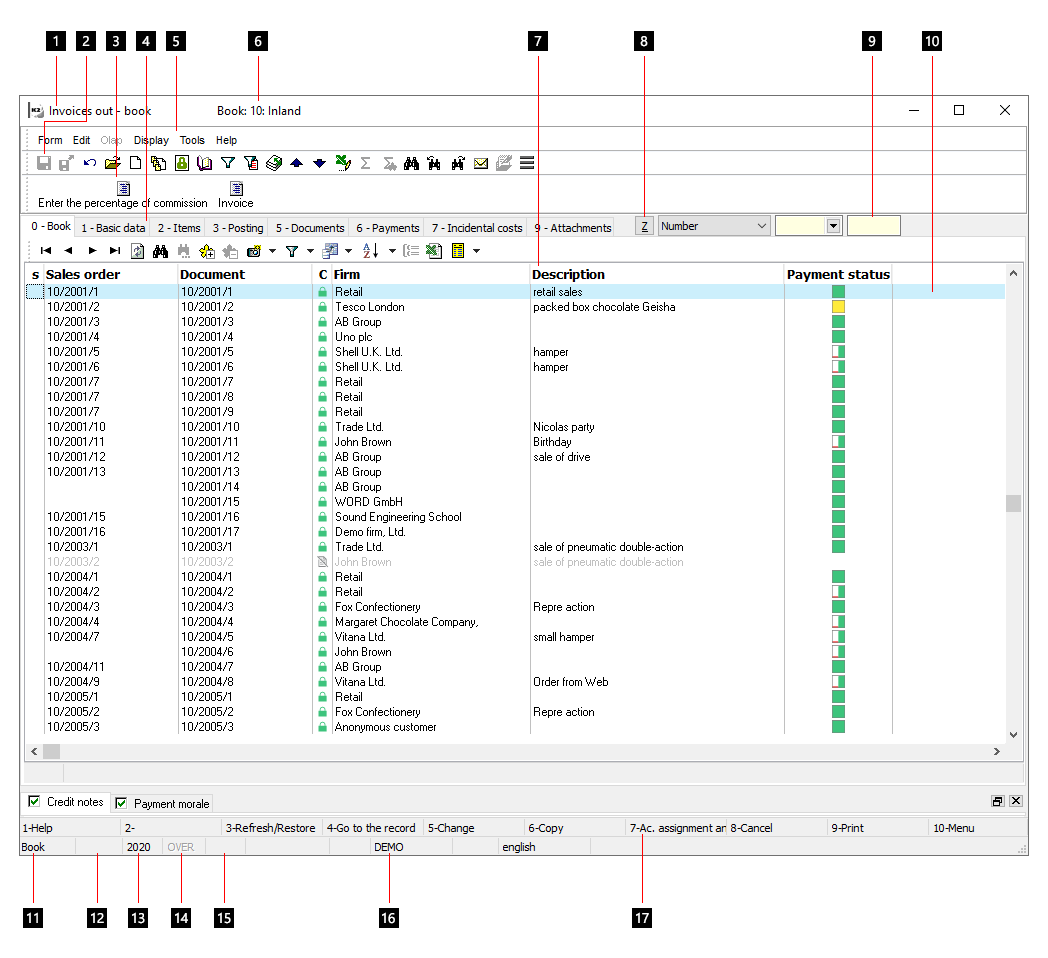
Picture: Book of Invoices Out
Item description. Table view
- Infomration about Current module - in This case , we are situated in Book - Invoices Out
- Module Toolbar - some functions of the appropriate module can be activated directly by a button from Toolbar
- User Toolbar - functions and reports submitted by a user. If all functions and reports don't fit in User Toolbar, then they will display at the end of the toolbar After this icon is clicked a list with reports and functions, which don't fit in the toolbar, will open.
- The so called Cards of a Document - by clicking left mouse button on individual numbers (0, 1, 2, 3, 4 etc.) you will enter browsing of the corresponding "page" of a document . The digits are underlined; it means that you can achieve the identical effect by pressing Alt+0 up to Alt+9 keys, respectively Alt+Right Arrow or Alt+Left Arrow. A Table (a Book) is represented by '0' (zero) page.
- Module Menu - through the menu of the list, functions related to thegiven module can be invoked.
- Information about Current book - in - in this case, you can see information from the book number 10: Inlands.
- Names of selected columns with Information about Table Items - an invoice serial number, a job order number for the corresponding invoice, a customer name, a description - i.e. an optional additional text, an invoiced amount for the corresponding invoice and so called flags - letters that inform whether the invoice is confirmed, settled or brought to book.
- Type of Sorting - it defines a function of a search field together with a type of sorting of the items in thebook. (Attention: If you enter into the field for selecting a type of sorting, the input field to enter a type of sorting will remain active. When you press some keys, you change the various types of sorting. Therefore, after you have chosen the type of sorting, it is necessary to click by mouse on the surface with book content. Only then the book is active and the search field is working. Therefore, it is much more practical o use the Alt+Z key for the selection of the type of sorting, respectively other keys that are underlined next to the field. In in this case, the sorting changes to in turn. The types of sorting are changed by Shift+Alt+Z key in the adverse order.)
- Search field (Locator) - a field that allows you to quickly search for the desired item in the book. Search Field - a field that enables a quick search of the requested item in the table (after entering the required invoice number in the search field and pressing Enter key, a light indicator is positioned on the required invoice). Search It is also possible to search in the book by arrows up and down.
- Table Items (Records) - a list of invoices in a book. There is a light indicator on the current invoice line.
- Information about the form status - information on the page0 can be displayed by means of 5 statuses - Book, Filter, Container, All and Quick Filter. If a filter is activated, a displayed list is not complete. (For detailed description of work with filters see the chapter Filters Alt+F9.) Status can be changed by clicking right mouse button in this field and then selecting a different status.
- Identifiers:
- Change - if we change Date in document items, identifier Change will display by press Enter key.
- Search - if fast search is activated (see the chapter Basic Functions - Search - Fast Search Alt+F7), Search identifier will be displayed at the same place.
- Period - documents are being issued within a currently selected period. This period is set in The module Administrator - User parameters. The displayed period can be changed by clicking right mouse button in this field in the status bar and selecting a different period from the launched code list.
- OVER has in K2 system the same function as in other programs (e. g. Word), i. e. that after pressing the Insert key we can overwrite the text in the field.
- Abbreviation of the stock which new stock documents will be created for. Likewise, the stock can be changed here in the same way as the period is (see point no. 13).
- Abbreviation of the Client for whom data are processed.
- Control Keys Description - F1 up to F10, Alt+F1 up to Alt+F10, Shift+F1 up to Shift+F10, Ctrl+F1 up to Ctrl+F10 and their combinations.
Form
You will enter a form from the table after you highlight the required record by the blue light indicator (by means of Arrows or the search field) and press Enter key or F4 key. Thus you will get to the 1stpage of the form.
The form usually has two or more pages. On 1. Firstpage contains basic (general) data; second page contains items related to a document. On 3. Thirdpage usually contains assignments and posting of the appropriate document, etc. Detailed data of any item in the table can be browsed in the form, they can be edited, complemented and confirmed.
The pages can contain other bookmarks which can provide additional information. The bookmark which we displayed the last will display with re-open of record. Every form "remembers" its last displayed bookmark.
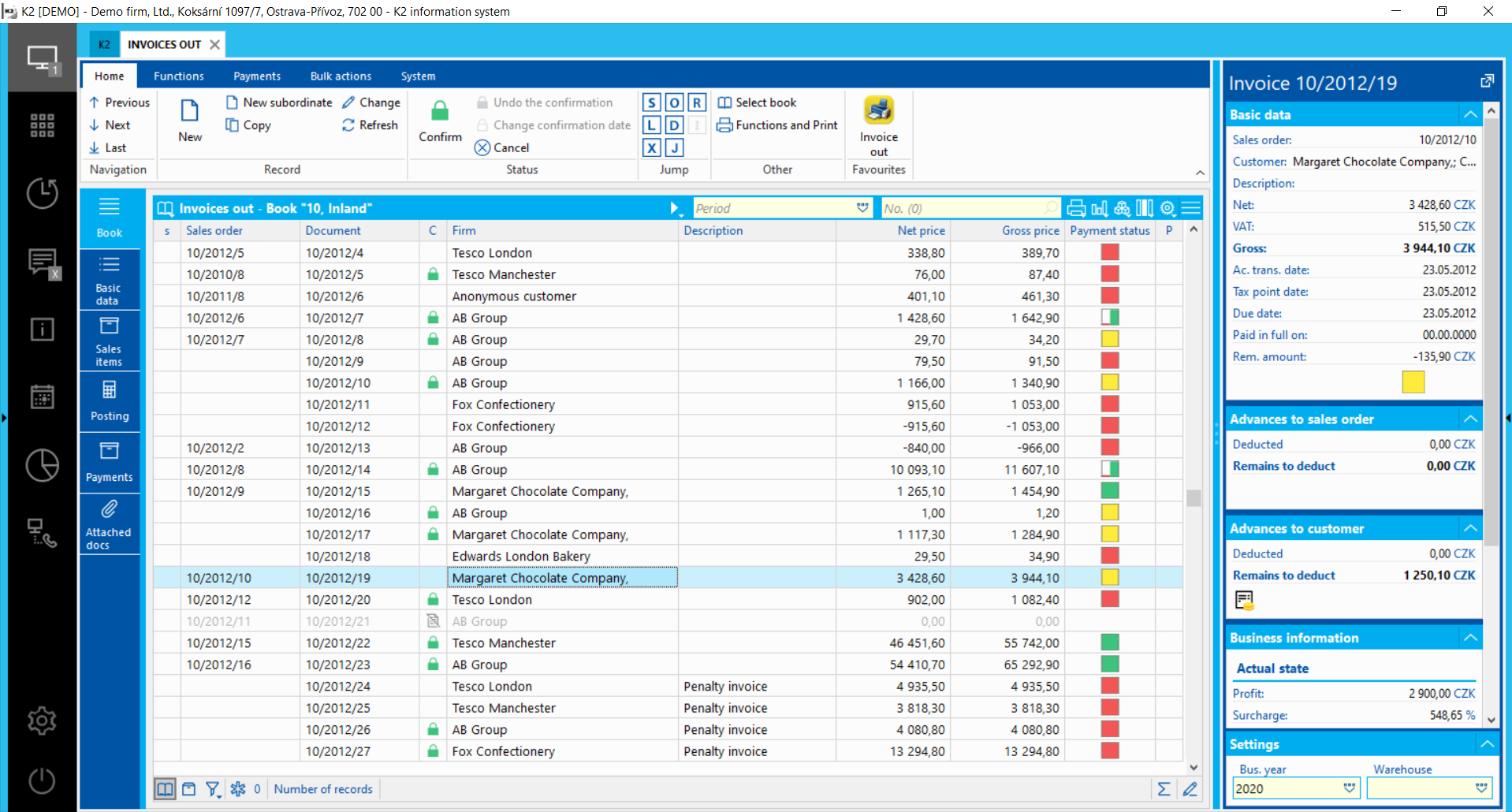
Picture: Invoice Out - 1st page Page chapter).
Universal Forms
The Book - Universal
The functionalities and rules of classic and universal forms are mostly similar. Universal forms are enriched with functionality that could not be further developed in classic forms.
The list corresponds to the Book in classic forms and it is the original zero page of the form. The rules for the List tab are similar as rules for book and a whole range of the common properties valid generally in each data module for List as a form. These settings are not separately defined for every form, but they are defined forthe whole module.

Picture: The Book - Universal
- Information about the form status - information on the page0 Records in the books may be presented by means of 3 status - Book, Container and Filter. If a filter or a container is on, the displayed list is incomplete (for the further description of the work with filters see the Filters Alt+F9 chapter.) The status can be changed by pressing left mouse button on the status icon.
- Information about Current book and status - in - in this case, you can see information from the book number 10: Inlands.
- Search field (Locator) - a field that allows you to quickly search for the desired item in thebook. Search Field - a field that enables a quick search of the requested item in thetable (after entering the required invoice number in the search field and pressing Enter key, a light indicator is positioned on the required invoice). Search It is also possible to search inthe book by arrows up and down.
- Column Setting - columns names and information about the displayed data.
- List Menu - through the menu of the list, actions related to the list tab can be invoked.
- Module Menu - through the menu of the list, functions related to thegiven module can be invoked.
- Record Preview - basic information about a record, on which a light indicator is currently positioned, are displayed. When switching to the another record, the information are changing depending on how the records are browsed.
- Setting - a book setting is a part of a record preview. In the Invoices book it is Business Year, in which the documents will be created, and Warehouse. The structure of the setting fields differs in each data module as needed.
- Selected - information about the number of selected records.
- Table Items (Records) - a list of invoices in a book. There is a light indicator on the current invoice line.
- Names of selected columns with Information about Table Items - an invoice serial number, a job order number for the corresponding invoice, a customer name, a description - i.e. an optional additional text, an invoiced amount for the corresponding invoice and so called flags - letters that inform
- Module Toolbar - there are included basic functions that can be performed with the data module or with a specific record on which the light indicator is positioned. Into this panel, it is possible to add reports and scripts from the Reports and Scripts book (F9) of the given data module. Editing and adding features is possible only by editing fragments.
- The so called pages (cards) of a document - by clicking left mouse button on individual tabs, you will get to browse the appropriate "page" of a document It is possible to switch pages by using Alt + right (left) arrow key. If some letter or character is underlined, it is possible to switch to the appropriate page by pressing Alt + underlined letter or character.
- Type of Sorting - it defines a function of a search field together with a type of sorting of the items in thebook.
The form - universal
You can get from the list to a specific page of the document by means of Alt + right (left) arrow key or by pressing the left mouse button on the specific page. Standard data modules have two or more pages, there are the basic data on the first page and other data, items or the attached documents and ext. documents on the other pages.
Each page may include other pages and different components that differ in the type and nature of the registered information.
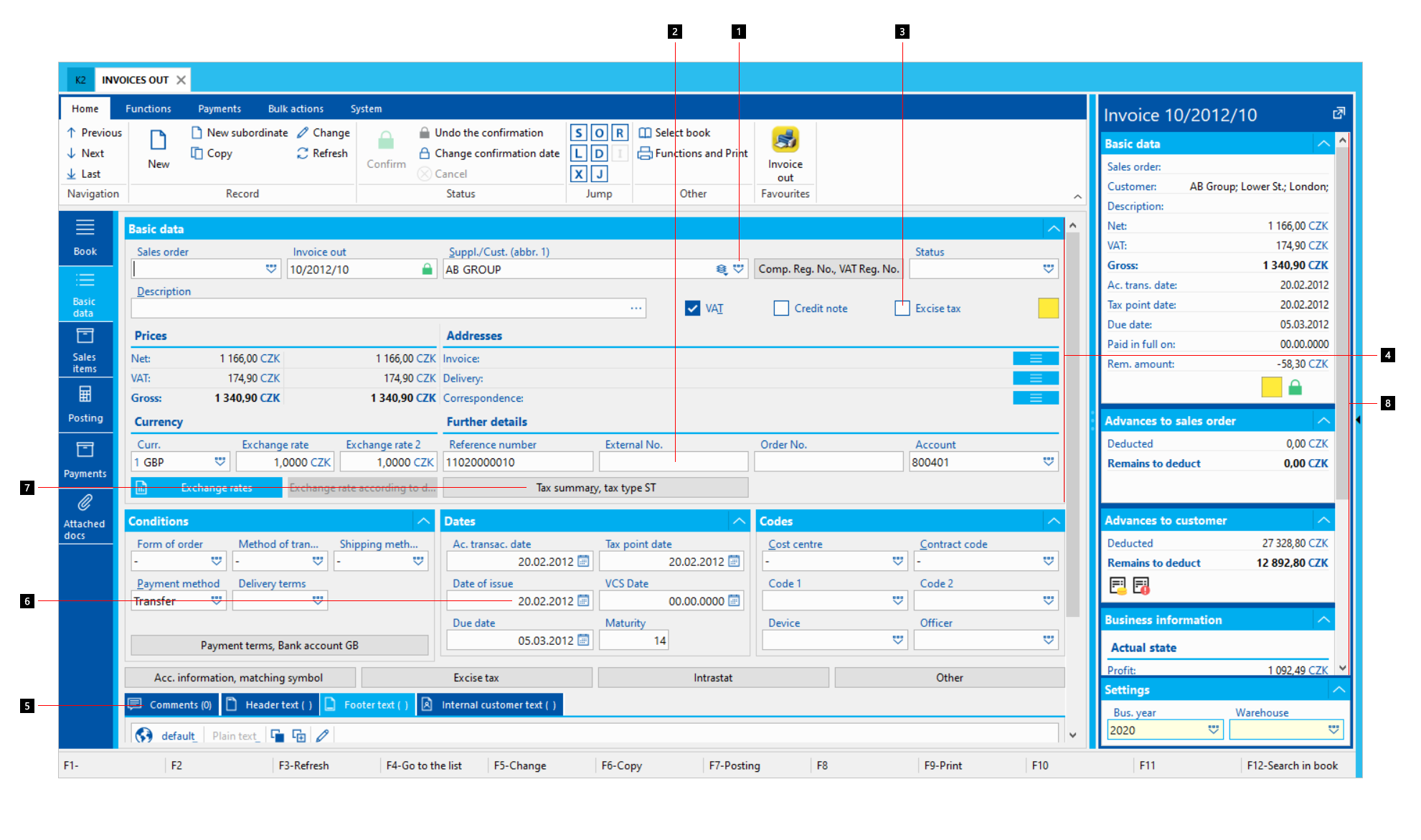
Picture: The form - universal
- Lookup - after clicking on the icon , you will see a list of values that you can fill in. By using the right mouse button in the field and by selecting Search option, you can switch the style of a displayed menu.
- Edit Box (edit) - a field, into which a value of the predefined type can be written (text, number, etc.).
- Checkbox - a field defining YES / NO.
- Drop-down panel (expander) - lets you hide or show other components.
- Tab - the page may contain additional pages (tabs) on which other components may be placed.
- Date field - a field in which it is possible to enter only the date. Simplified filling in
- 1+.+ ENTER - the first day of the current year and the current month is pre-filled
- .+1+ENTER - the current day of the first month of the current year is pre-filled
- .+ENTER - the current day is pre-filled
- Button - after pressing the button, actions can be started, floating form can appear or the other fields can be shown or hidden.
- Preview - summary information about the displayed record.
System of K2 Menu
InK2 Programme there are available various systems of menu that are dependant on a part of the programme you are currently positionedin.
Module Menu
Menu in terms of particular modules is available here. The module menu functions are accessible in within all forms (including the table) of the given module. The module menu functions are described in Basic functions - Module Menu Functions chapter.
![]()
Picture: Module Menu of Invoices Out
Tree Menu
K2 Information System also supports user's programme control by Tree Menu. The tree menu contains a basic selection of default functions (books, code lists, reports, scripts) available in the programme.
Work in the tree structure is very easy and transparent. The menu is divided into folders according to individual functional areas while each folder is divided into other subfolders which contain the individual functions.

Picture: Desktop K2 with Expanded Tree Menu K2
Meaning of Icons in Tree Structure:
![]() Rolled Node (Module).
Rolled Node (Module).
![]() Expanded Node (Module).
Expanded Node (Module).
![]() Books (Lists) of Appropriate Module (Goods Book, Contractors Book or similar).
Books (Lists) of Appropriate Module (Goods Book, Contractors Book or similar).
![]() Code Lists (e.g. Chart of Accounts, Customs Tariff, etc)
Code Lists (e.g. Chart of Accounts, Customs Tariff, etc)
![]() Documents filter with preset conditions.
Documents filter with preset conditions.
![]() Print Reports.
Print Reports.
![]() Functions or scripts creating new data.
Functions or scripts creating new data.
![]() Searching.
Searching.
![]() Recalculations of States.
Recalculations of States.
![]() Statistics, Evaluating.
Statistics, Evaluating.
![]() Setting of data in the system K2.
Setting of data in the system K2.
![]() Module Functions, Data administration.
Module Functions, Data administration.
Programme Basic Control
The basic principle of IS K2 control bears upon three basic modes: Browse, Change and entering of New records. The mode Delete of records is prohibited because of the data consistency.
Records in Browse Mode
In Browse mode it is possible to browse a document in details but it is impossible to change it. A record will be displayed on the screen after it is selected from the table by pressing F4 key or Enter key. After pressing Esc key it is possible to return from the document to the table. You can also return from the selected document to the table by pressing F4 key or Alt+0 keys.
Attention: A click on the checkmark in the window close box quits actions in the whole module; it means it also quits zero page of the document.
More Precise Description of Possibilities inBrowse Mode: Browse Mode
enter a document Book |
F4, Enter, resp. Alt+1, ... - page number |
Return to the table (froma module) Modules |
F4, Esc, resp. Alt+0 |
Transfer On second or Next Document page |
Alt+2, ... or Alt+Right Arrow, by pressing left mouse button on selected bookmark. |
Scroll among various documents |
Grey Plus (numeric keyboard plus) - forward, Grey Minus (numeric keyboard minus) - backward |
confirm a document |
Alt+F2 |
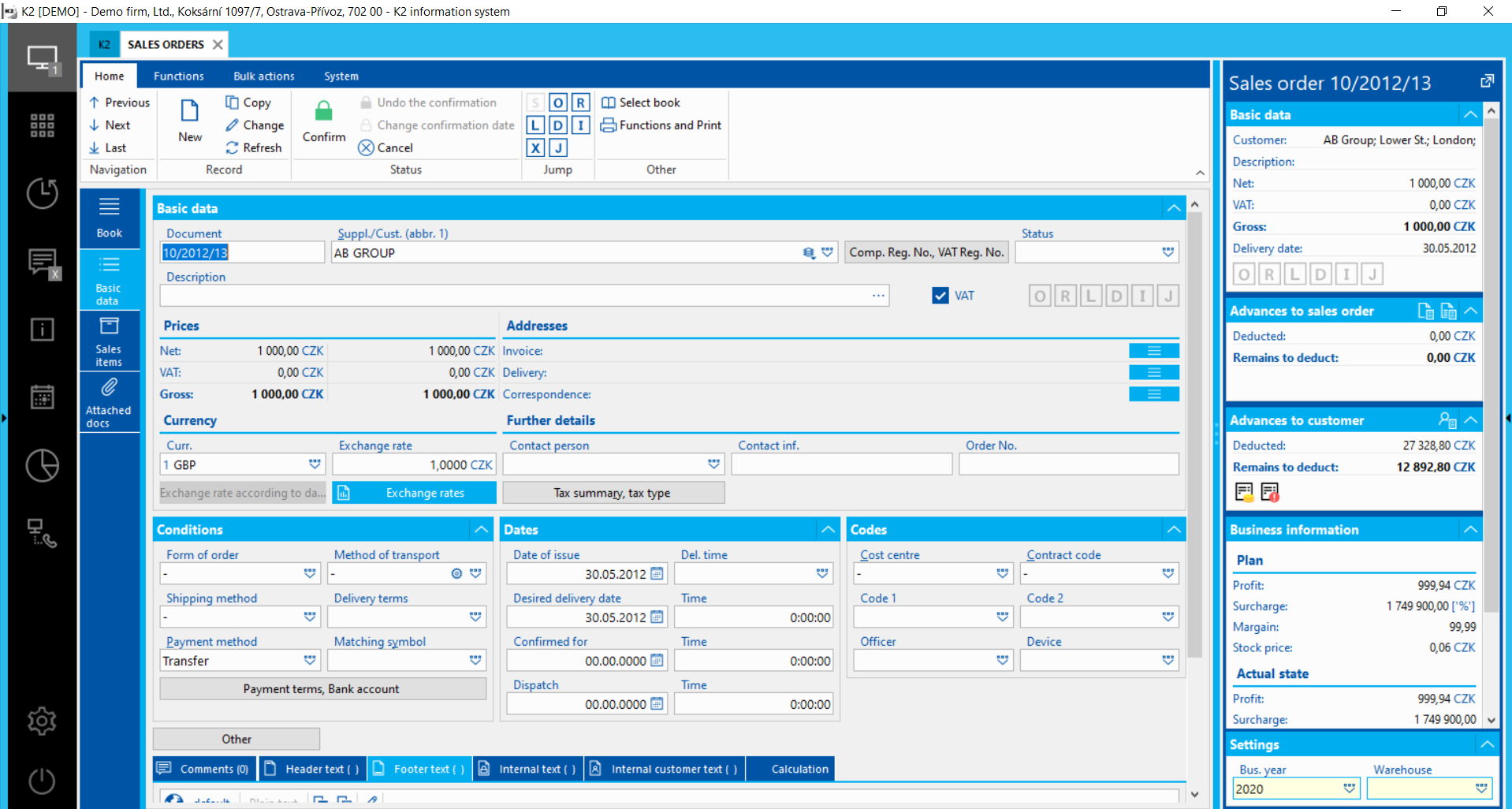
Picture: The Sales Order - 1st page in Browse Mode
Records in Change Mode
It is possible to change the data in Change mode but only for the records that have not been confirmed yet. In the case of the confirmed documents it is impossible to enter Change mode.
More Precise Description of Possibilities in Change Mode:
enter a document |
F5- from Book or even from Document in Browse Mode right mouse button, Change possibility - on the 0 th page of document Document page |
Return to the table (or to a document in Browse mode) Browse Mode |
Esc |

Picture: The Sales Order - 1st page Contract - 1st page - Document in Change Mode
It is necessary to save the changed document by pressing F2key. It is typical for a document in Change mode that the fields that can be changed are editable (highlighted by white colour). If you enter a document in Change mode, the zero bookmark will not be displayed and it is impossible to switch to the zero page of the document.
New record creation
To create a new document, press the Ins key (only in book), or by copying a previously created document (using the F6 key or using the icon ![]() from books, or from document in Browsing). You can edit or complement the necessary data in such a created copy. The usage of F6 key is advantageous in hose cases when a new document contains most of the data identical with the data in the selected and already completed document. It is feasible to set up a new document also via a specimen by means of Shift+F6 keys.
from books, or from document in Browsing). You can edit or complement the necessary data in such a created copy. The usage of F6 key is advantageous in hose cases when a new document contains most of the data identical with the data in the selected and already completed document. It is feasible to set up a new document also via a specimen by means of Shift+F6 keys.
More Precise Description of Possibilities in Setting up of New Records:
enter a document |
Ins - only from the book if an absolutely new document is created F6, Shift+F6 - from book and from Browse mode during a document copying. right mouse button, New possibility - on the 0thpage of document Document page right mouse button, Change possibility - on the 0thpage of document |
Return to the table (or to a document inBrowse mode) Browse Mode |
Esc |
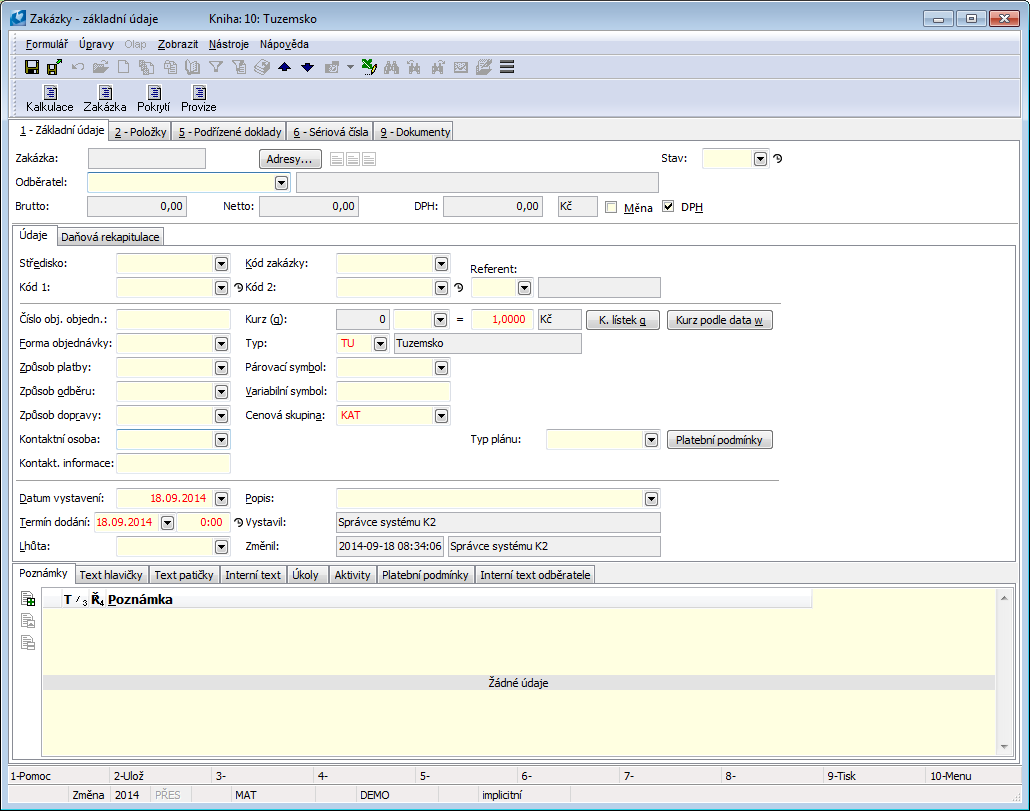
Picture: The Sales Order - 1stpage Contract - 1st page - New Document
It is necessary to save a new document by pressing F2 key. It is typical for New Record Mode that document fields that you can paste are highlighted by white colour and document items that you can rewrite are highlighted by red colour. After switching to Change mode (by saving) the letters will change to standard colour (black).
It is possible to create a new document by means of a Wizard for new documents creating (for example inthe book of Invoices Out). Books of invoices out
Records in Delete Mode
Deletion of some parts of the records (document items) is performed standardly by Del key, resp. F8 key. Considering Because ofthe fact that deletion of the whole records is in most cases prohibited, F8 key serves for cancellation or ignoring of the appropriate record.